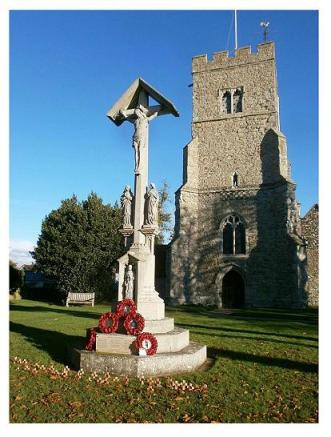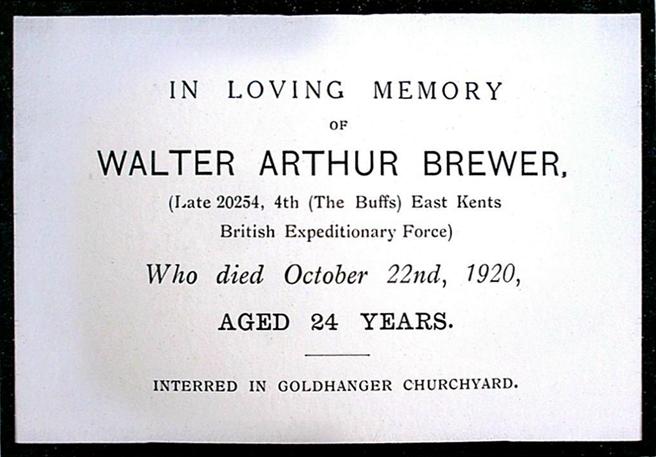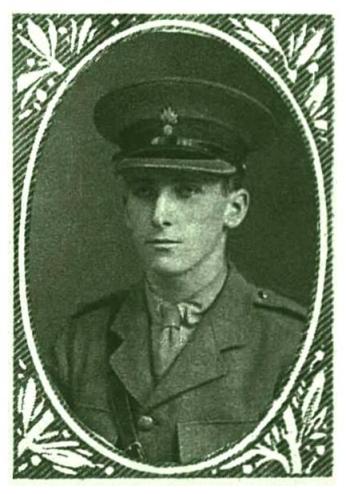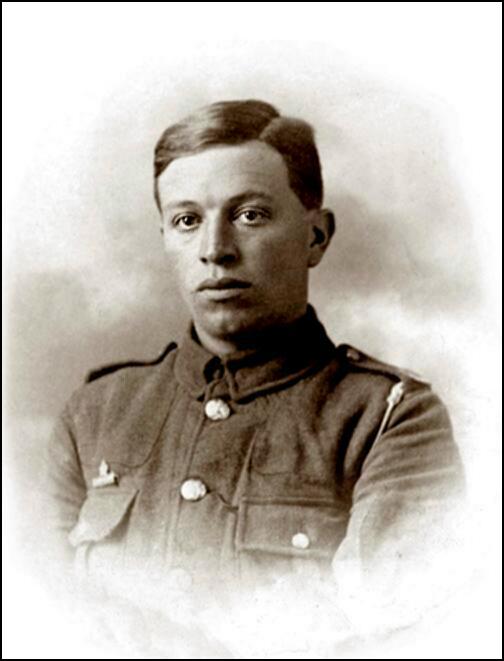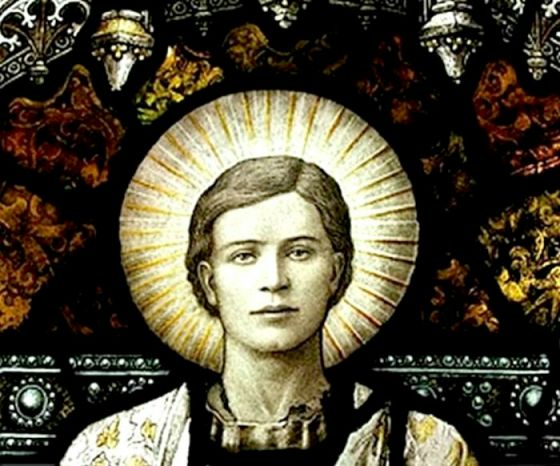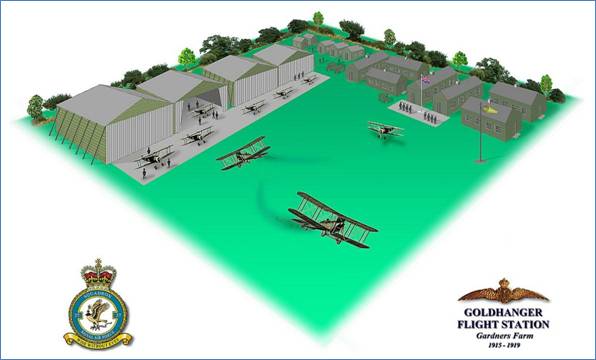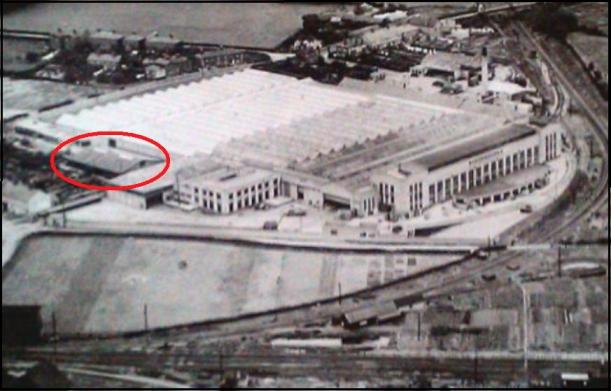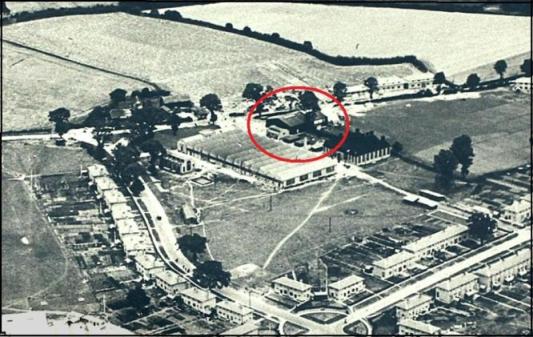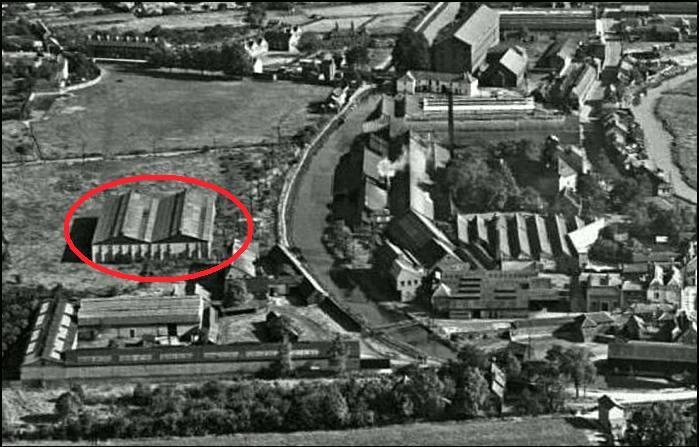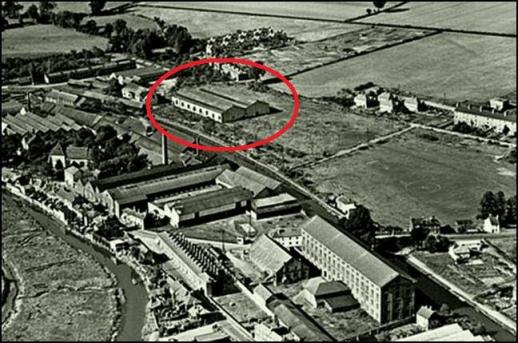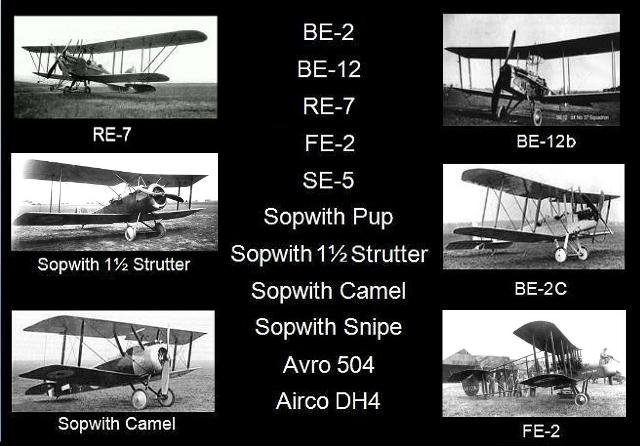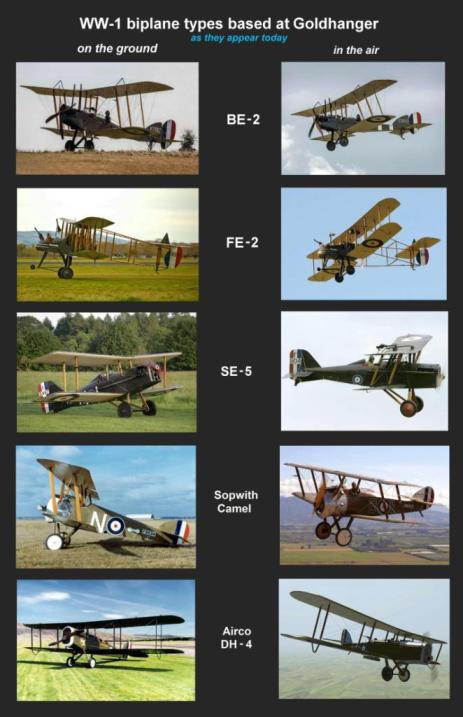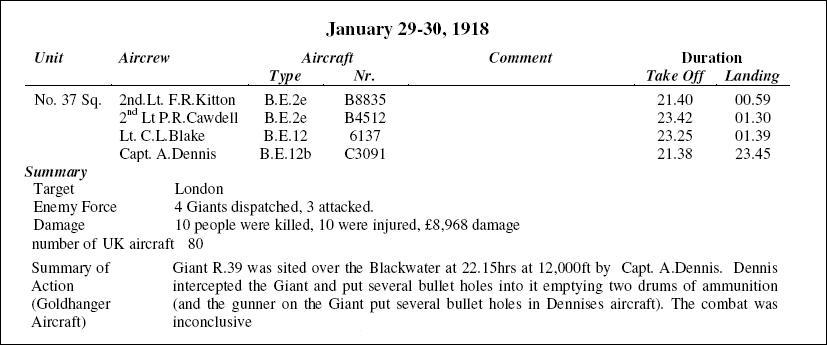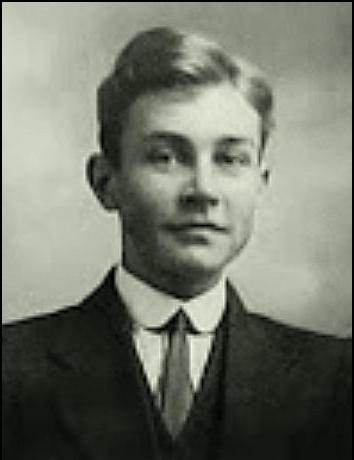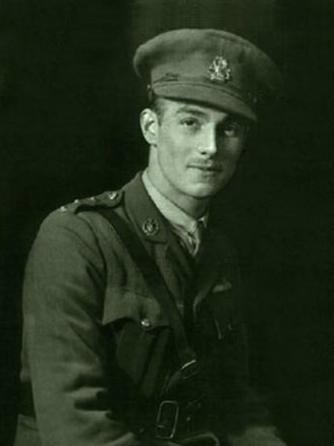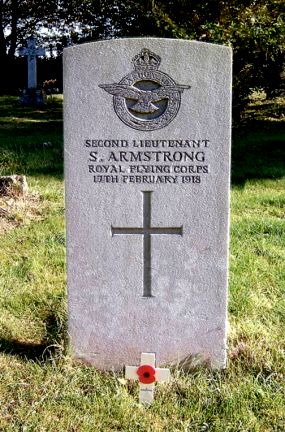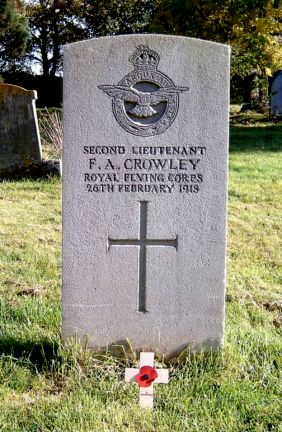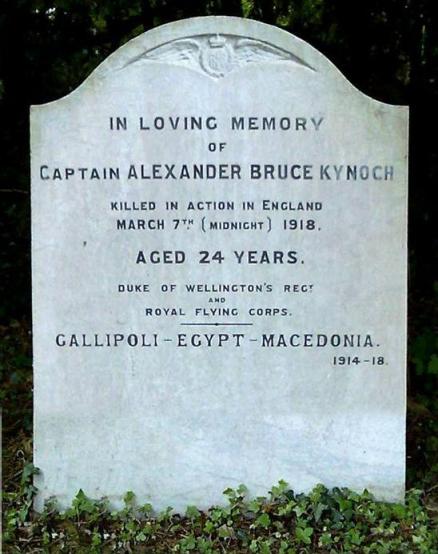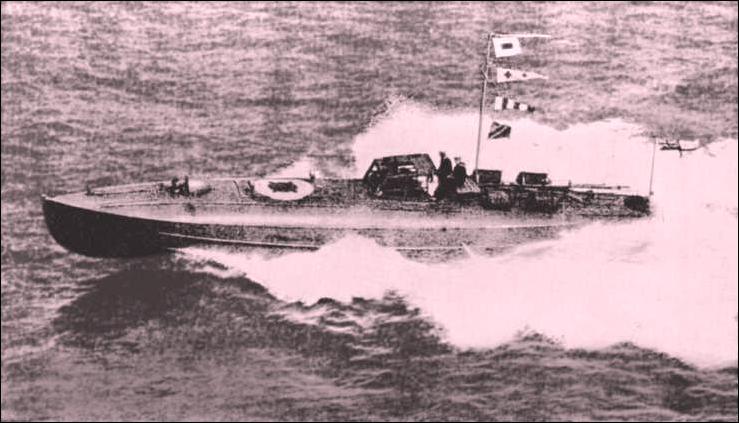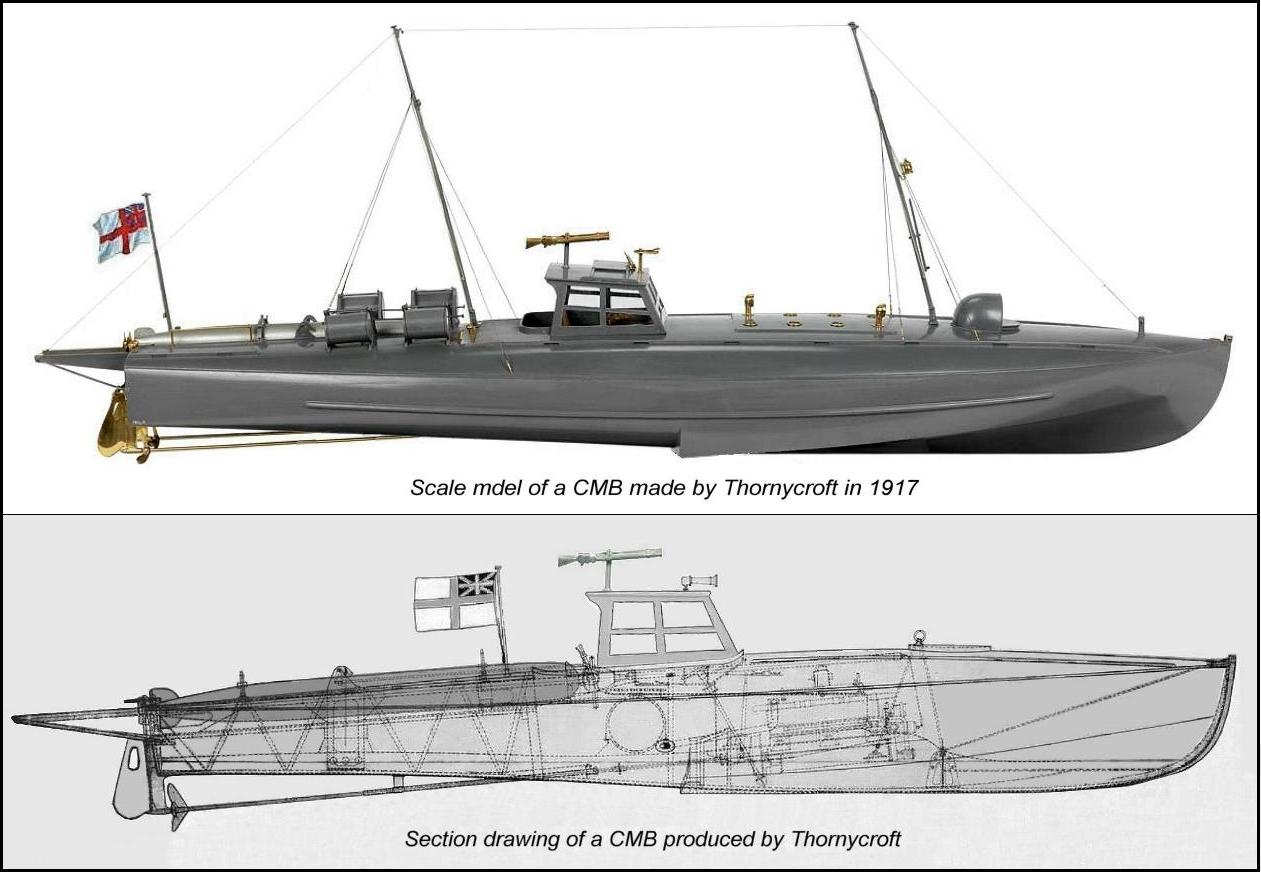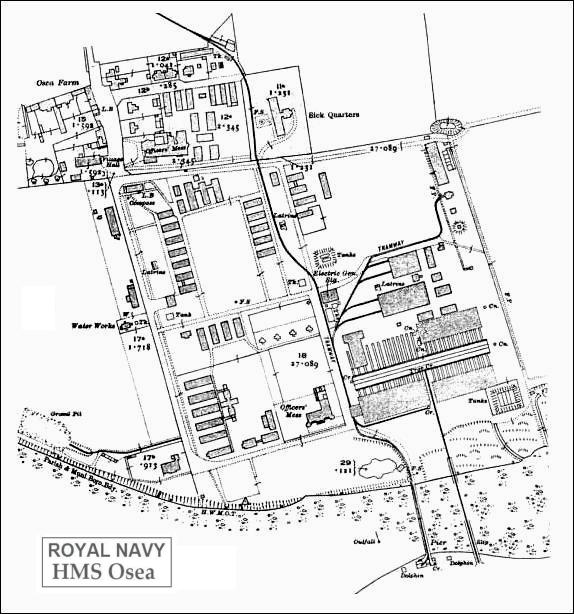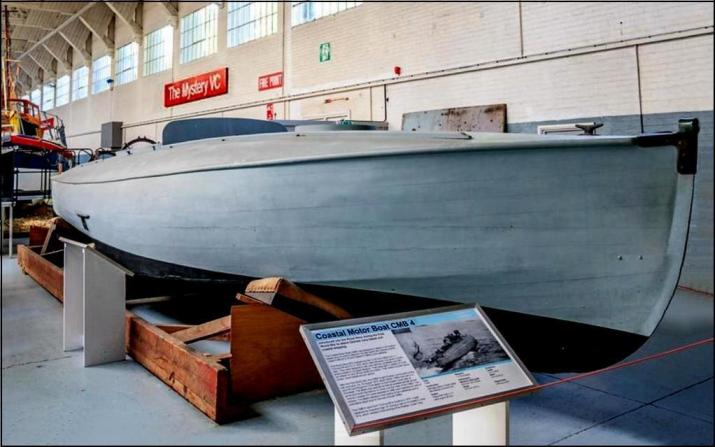|
o Obituaries given in the Parish Magazines o
Those
not named on the memorial o Other
Parish Magazine reports of Great War related activities o Commemoration
of the 100th anniversary ...and the addition of a new plaque o Great War
Armistice Celebrations ...then and in 2018 o Honouring the
Goldhanger men killed 100 years on o Goldhanger
Red Cross members o The Goldhanger Flight Station o Zeppelin
Busters over the Blackwater o HMS Osea followed by. . . |
Compiled mainly from information in the
parish magazines of the day
|
The Goldhanger War
Memorial in
the form of a Calvary, was
dedicated on Friday 25 July 1919 The
inscription on the plinth reads TO
THE GLORY OF GOD AND IN MEMORY OF MEN OF THIS PARISH WHO
GAVE THEIR LIVES IN THE GREAT WAR 1914-19 The
names inscribed on the memorial and
are listed in approximate order of
date of death. |
|
William Hume William Hummerston Thomas Coker James Seaborn Harry Johnson Henry Lewis Sydney Brewer John Wakelin Ernest Brazier Lionel Hover Walter Brewer Harry Pennick Cyril Gardner Sydney Armstrong Ernest Everett Augustus Crowley Dick
Phillips |
William Hume
The Parish magazine of November 1914 records:
With
deep regret we have to record the death of William Hume. Whose life was
sacrificed in the service of his country on HMS Hawke, which was sunk by a
torpedo from German submarine in the North Sea. The Hawke sank in a few
minutes, with the loss of her Captain, 26 officers and 500 men - only 4
officers and 60 men were saved. Very deep and genuine sympathy has been felt
for his mother, Mrs. Hume, and for all members of his family in the heavy grief
that has befallen them.
William
Hume was the first Goldhanger man to lose his life in the Great War and the
15th October 2014 was the 100 year anniversary of William’s death. To mark the
occasion the bells of St Peters were rung at 11am on that day. Hear the bells
at...
William Hume's 100th year
aniversary
In
recent years more information has become available about this tragedy. Here are
images and websites dedicated to that event...
William Hume and the sinking
of HMS Hawke
Thomas Coker
8019
Private 2nd Battalion Essex Regiment. Died 5 March 1915. Age
unknown.
Buried
at Calvoire (Essex) Military Cemetery in Grave I.H.1.
The
Parish magazine for April 1915 records:
The
account published in our last number –for March- of the death of Mrs. Thomas
Coker (Ethel Emma), on February 14th, meets with its tragic sequel in the death
of her husband in the trenches 3 weeks later; which it is our painful duty to
record here. He appears to have been alive and well at one moment and dead the
next, as he was seen and spoken to by a friend the same morning. It happened at
Le Gheers (Belgium), on Friday, March 5th. He rejoined the 2nd Batt. Of the
Essex Regiment on the outbreak of war, and had so far been untouched. He
appears to have been struck by a stray bullet, and the effect was
instantaneous.
Harry James Johnson
1829
Private 5th Battalion Essex Regiment. Died 17 August 1915. Aged 18.
Son
of Samuel James and Ellen Johnson of 2 Church Street, Goldhanger. Unknown
grave. Commemorated on Panel 144 to 150 or 229 tp 233 of the Helles Memorial
(on the tip of the Gallipoli peninsula). The
Allies landed there on 25/26 April 1915 and evacuated during December 1915 and
January 1916 there having been no serious action after the end of August 1915.
The Parish magazine for October 1915 records:
The terrible news of the early death of dear Harry was a
great shock to us all. It was a noble death for a lad to die - no end can be
more glorious than dying for one’s country in a righteous cause – but then, he
was so young. He died at Alexandria, on August 17th, in hospital, from wounds
received on August 9th, and on August 21st fell his birthday, when he would
have been 19 years of age! Such a child - simple, kind-hearted, and generous of
nature. At his memorial service held in the church on Sunday afternoon, Sept.
5th, fully 60 were present, including the members of his sorrowing family, for
whom such deep sympathy is felt, as well as a genuine sorrow for the promising young life thus suddenly cut short.
P.S. Dear Sir.
You are at liberty to put this in the magazine so as the people of Goldhanger can see it
and be very proud of your good deed.”
Many
of us will pray that his soul may be granted eternal Rest and Perfect Peace.
Parish magazine December
1915:
Harry
Johnson
The Officer Commanding the 1/5 Essex at the
Dardanelles, Lt. Col. Gibbons, has written a letter to the Rector respecting
the death of Harry Johnson, which he concluded by saying, “His relatives may
like to know that I am satisfied that the Officer’s account is correct, and
that he died from the shock of the shell, his death being instantaneous. He was
a fine young
fellow, and although I had frequently to admonish him for untidiness in his
dress, he was a good soldier with a good character in the Regiment, and
absolutely without fear. I only wish I had many more like him.”
Of such a tribute of praise his family may feel proud.
Two of Harry Johnson’s medals were offered for
auction at Noonans Mayfair Auction rooms in London in June 2025 with these words... "Private H. J. Johnson,
Essex Regiment, died of wounds at Gallipoli on 17 August 1915. He served with
the 5th Battalion during the Great War at Gallipoli from 9 August 1915;
disembarked via flat-bottom boats at 'A' Beach, Suvla Bay on 9 August 1915,
Johnson and his comrades soon found themselves facing determined Turkish
resistance. Mortally wounded, he died of wounds just a few days later on 17
August 1915. He has no known grave and is commemorated upon the Helles
Memorial, Turkey”.
Sydney Charles Brewer
8018
Lance Corporal 1st Battalion Essex Regiment. Died 1 July 1916 (The Parish Magazine quotes 20 July) during the Battle of the Somme. Aged
30. Husband of Lavinia Maud Page (formerly Brewer) of 8 Priory Gardens, Great
Yarmouth. Buried at Knightsbridge Cemetery, Mesnil-Martinsart Grave F.44.
The
Parish magazine for June 1915 records:
With
deep regret we record that Sidney Brewer, serving at the front with the 2nd
Essex Regiment, has been wounded again – for the third time – this time in the
back and legs, probably a shell wound, and is again in hospital – for the
fourth time. We hope he may be invalided home. Deep sympathy is felt for his
wife and parents in their great anxiety, and many, we are sure, will pray for
his recovery.
Parish
magazine August 1916 reported:
The
sad news came to us on Thursday, July 20th, that Sidney Charles Brewer had been
“killed in action”. Nothing further has at present been received but we hope to
hear particulars later on. A Memorial Service was held, on Sunday evening, July
23rd, and a large number were able to attend and show their deep sympathy. It
is hard to lose a relative or friend, but who can grudge them the honour of
serving their country even to the sacrifice of their lives.
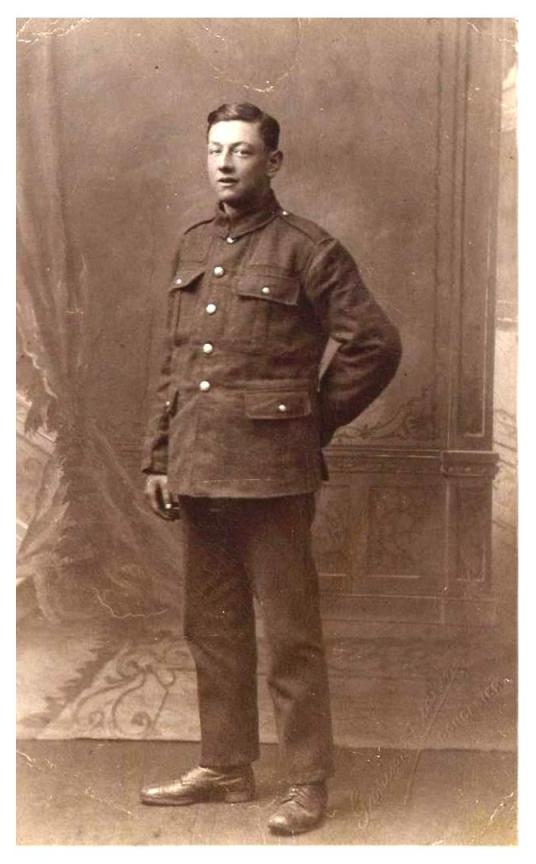
Ernest (Dick) Victor Brazier
6610
Private 2nd/4th Battalion Royal Berkshire Regiment. Died
19 July 1916 during attack on Fromelles by 61st (South Midland) Division. Aged
21. Son of Joseph and Sarah Brazier of Highams Farm, Goldhanger. Buried in
Grave II.G.15 at Laventie Military Cemetery, La Gorgue.
The
Parish magazine of August 1916 reported:
Following
closely came the news that “Dick” had lost his life at the front. His Commanding
Officers wrote sympathetic letters to Mrs. Brazier, in one of which it was
said, Dick was a “brave, fearless soldier and very well liked in the Battery,
he made many friends and, needless to say, is very much missed”. A memorial
service was held, in Church, at 3-45, on July 30th. Many came to show their
sympathy for his family and the last token of respect for him. What more can be
said of both? They did their duty. May they rest in Peace.
Walter Arthur Brewer
Died
of wounds 22 October 1920, aged 24, son of Henry and Eliza Brewer of Fish
Street. He is buried in St Peter’s Churchyard next to Dick Phillips.
|
Walter
Brewer’s funeral card |
Parish magazine November 1920 reported: WALTER ARTHUR BREWER Seldom has the passing of a young life made a
deeper impression, or stirred up a deeper sympathy than that of Walter
Brewer, whose call to Rest after a long and trying illness of which little or
no hope could ever be entertained, came on Friday evening, October 22nd, at 7
o’clock, when he passed peacefully away. He joined the “Buffs” and went out
to France at the call of duty in 1917, three months later he contracted his
fatal illness, and was discharged from the Army in October of that year. With
what strength remained to him, he took the keenest interest in the Parish
Room (in Head Street where ‘Wheelwrights’ now stands) recreations of
which he was the energetic secretary, and in everything that concerned the
social well-being of the Village. |
|
His remains were laid to rest in the Churchyard,
in the presence of a very large and sorrowful gathering on Wednesday
afternoon, October 27th, at 3-30. The bearers were six of his friends. The
choir, accompanied by the Rector, the Rev. B.H. Durrant-Field and the Rev.
C.A.M. Stewart, met the Funeral Procession at the Church gates. “O Rest in
the Lord” was played on the organ as the Church was entered. “Thy will be
done” and “The radiant morn has passed away”, the two hymns chosen, were sung
with deep feeling, followed by “The Dead March” as the move was to the
grave-side. |
|
Cyril Gardner
Lieutenant 3rd Battalion Grenadier Guards. Died
14 September 1916. Age unknown. Son of the Revd. Gardner, Rectory of
Goldhanger and Little Totham at the time. Commemorated on Pier and Face 8D of
the Thiepval Memorial to the "Missing of the Somme", he being one
of the 72,000 officers and men who have no known grave. The East window in
Little Totham church is a memorial to him. Parish Magazine November 1916: The Rector writes. . . Dear People, |
|
I
desire to thank you for your many expressions of sympathy with me and my dear
wife in our grief. It was unfortunate that it happened to come just at a time
when I had so little strength to stand against it. We have received many
letters (over 400) all expressing sympathy, or eloquent in appreciation,
including a number from Officers and Men of the Grenadier Guards. I am glad to
know so many were present at his Requiem that Saturday morning.
The
following obituary from the “Morning Post” was also reproduced:
Lieutenant
CYRIL GOWER GARDNER, Grenadier Guards (recently returned as missing, believed
killed, and now officially reported killed in action, September 15) was the
elder of the surviving sons of the Rev. Frederick and Mrs. (Ethel Mary) Garner,
of Goldhanger Rectory, Witham, Essex. After being educated at Bilton Grange,
Stubbington House, and Haileybury College, he passed into the Royal Military
College, Sandhurst, in April last year, where he became sergeant of his
company.
He
joined the Grenadier Guards as second lieutenant on September 15th, and
received promotion to Lieutenant from that date. He went out to the front last
August, and took part with the Guards Brigade in the successful advance of
September 14th, and was killed on the 15th (the first anniversary of his
joining) almost instantaneously from a bullet wound. During his short career he
had become a popular young officer, and his Colonel speaks of the great promise
he showed. In writing of the battle on that day a brother officer says: “No
officer there went forward more bravely or more resolutely to do his duty than
he did,” and regrets that “such a charming-personality has been lost to the
regiment.”
A
Memorial Service was held at Goldhanger Church simultaneously with the service
for the fallen officers and men of the Grenadier Guards held in London.
Lieutenant Gardner was nineteen years of age.
Parish
magazine January 1917:
H.M.
the King has been graciously pleased to send the Rector the following telegram:
Buckingham
Palace. November 27th.
The
King and Queen deeply regret to learn that it is now officially confirmed that
your son who was previously reported as missing has fallen in the service of
his Country. Their Majesties deplore the loss which you and the Country have
sustained and truly sympathize with you in your sorrow.
Keeper
of the Privy Purse
Ernest Everett
29334
Lance Corporal 1st Battalion Essex Regiment. Died 14 April 1917. Age
unknown. Unknown grave. He is commemorated on the Jerusalem Memorial in Israel.
The
Parish magazine of May 1917 reported:
The
anxiety of Mrs. Everett and Mrs. Frost for their son’s safety is deeply shared
by us all and the two families are receiving the sympathy as well as the
prayers of not a few. In the Battle of Gaza, on March 26th, Willie Frost was
wounded, and is now somewhere in hospital, but where, is not at present known.
On
the same day, Ernest Everett was also wounded and is reported as “missing” as
well, which is far more serious and we can only pray for his ultimate
restoration to us. The writer has received three letters about him from the War
Office, and at present no further details can be gathered, but every enquiry is
being made.
William Hummerston
54892
Lance Corporal 16th Battalion Welsh Regiment. Died 1 August 1917.
Age unknown. Grave IX.E.38 at Ypres Reservoir Cemetery.
See Parish magazine entries for September 1917 and
October 1917 below…
Allen James Seaborn
393019
Rifleman 1st/9th Battalion London Regiment (Queen Victoria’s Rifles). Died 13
August 1917. Aged 21. Son of Joseph and Alma Seaborn, of Baker’s Green, Little
Totham, Maldon, Essex. Commemorated on Panel 54 Ypres (Menin Gate) Memorial.
Parish
magazine September 1917:
IN MEMORIAM
JAMES SEABORN and WILLIAM HUMMERSTONE
A
heavy cloud of sorrow has burst over us this last month. The battlefield has
claimed two more precious young lives from us here in Goldhanger that we could
never spare.
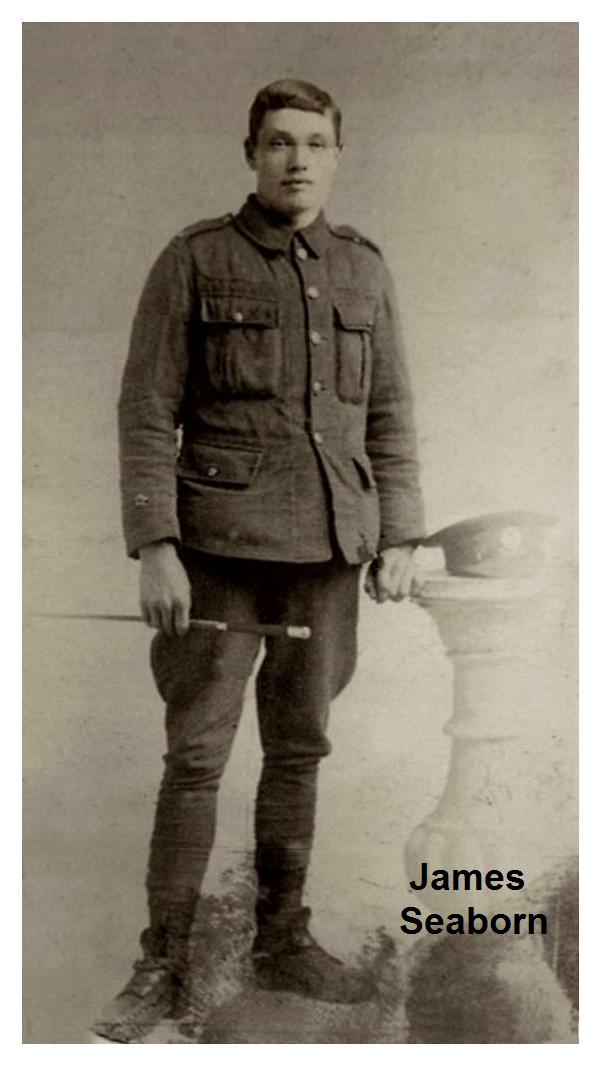
William
Hummerstone has become one of us through his marriage here two years ago to
Lily Phillips, and the depth of the tragedy of her short and happy married life
being so pitilessly and suddenly cut short cannot easily be measured. Everybody
grieves for her, and quite rightly. He fell in action, bravely doing his duty,
on or about August 1st but where, it is not stated, and full enquiries are
being made. He was of blameless character and his influence was for good
wherever he went.
James
Seaborn fell between August 12th and 14th. He had been transferred from the
Essex Regiment to the 1/9 London Regiment, but where or how he fell is not yet
definitely known. As all are aware who knew him – his lovable nature and
charming disposition – a boy for any parent to be justly proud of, and all our
hearts go out in the deepest sympathy to his father and mother and brothers and
sisters, as well as to her to whom one day he was to make his wife. The spirit
of resignation is there, and we can only pray that time will prove to be a
healer to their sorrow. He was 21 years of age.
Ernest Henry Lewis
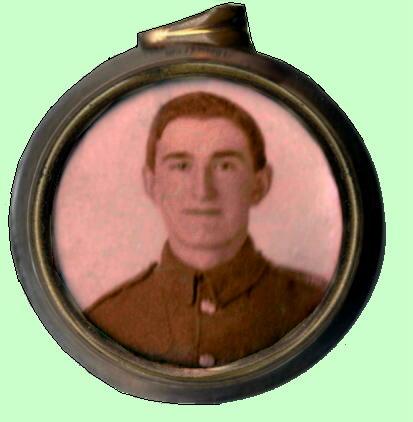 202529
Private 2nd/4th Battalion Royal Berkshire Regiment. Enlisted in Chelmsford.
Lived in Witham. Died 21 March 1918 (Soldiers Died in the Great War CD says 3
April 1918). Aged 25 (24 in Parish magazine). Son of Maurice and Emily Lewis of
Church Street, Goldhanger. Buried near N.W. corner of Churchyard at
Ugny-L’Équipée.
202529
Private 2nd/4th Battalion Royal Berkshire Regiment. Enlisted in Chelmsford.
Lived in Witham. Died 21 March 1918 (Soldiers Died in the Great War CD says 3
April 1918). Aged 25 (24 in Parish magazine). Son of Maurice and Emily Lewis of
Church Street, Goldhanger. Buried near N.W. corner of Churchyard at
Ugny-L’Équipée.
Harry Lewis was a member of the bellringing band.
On 31st October 1914
a short peal of 720 College Exercise was rung “as a farewell to H. Lewis on
joining the Army.” On 28 April
1918 a short peal of 360 Plain Bob was rung on muffled bells “as a last mark of
respect” for H. Lewis.
John Sidney Wakelin
|
|
Private 29360 of the 10th Battalion Essex Regiment and a former
Territorial soldier. He enlisted in Chelmsford. John Wakelin Died 24 March 1918,
aged 27 and is commemorated on panel 51 and 52 at Pozières Memorial and a
window in the south wall of St Peters, Goldhanger, as shown here. He was one
of 14,000 troops with no known grave killed at Rouen Wood on the 4th day of a
German counter attack over the Somme battlefields. |
|

Lionel Douglas Hover
202173
Private (Signaller) 11th Battalion Essex Regiment. Died 28 October
1918. Aged 21. Son of Henry Alfred & Beatrice Hover of 12 Spring Crescent,
Tolleshunt D’Arcy. Buried in Grave I.B.32 at St Souplet British Cemetery.
Parish
magazine December 1918:
Obituary
LIONEL HOVER
The
deepest and truest sympathy has everywhere gone out to Mr. and Mrs. Hover, in
their loss of one of the most promising of sons. Lionel has been killed in
France. He was lying in his shelter in the act of writing to his mother at the
very end of October. Full particulars are not yet to hand. He was thoroughly
good and beloved by everyone. He was the first Volunteer to offer himself at
our recruiting meeting at the outbreak of the war, and turned out to be such a
keen and efficient soldier. So soon he might have been home, with the laurels
of Victory upon him, but God willed it otherwise. Fuller particulars may be
given next month, meanwhile we all mourn his loss.
Joseph Harry Pennick
Joined
5th Bn Essex Regiment of the Territorial Army on 16 May l 913 and Joined the regular
army in March 1916: G/21608 Private, 2nd Air Mechanic, 59 Squadron, The Royal
Flying Corps. Contracted Tuberculosis on active service in France and was
discharged as unfit on 3rd Oct 1917. Died of TB on 27 March 1918 aged 21 at his
home in Fish Street. Buried in plot 162 Goldhanger churchyard, a cast iron
memorial cross lies against the back wall of the churchyard. He was the son of
John and Charlotte Pennick of Fish St.
The
Parish magazine of May 1918 reported:
The
Storm Cloud has cast a very deep shadow over Goldhanger during the past month,
and was to be expected, has at length burst, bringing with it heavy sorrow not
only to the three homes most directly affected, but to every inhabitant who
mourns a very serious loss. The three lives that have been taken were very
valuable and all so full of great promise, each greatly loving, and also vey
much beloved. They have been taken out of tribulation to enter on e much fuller
and happier life, in far closer union with their common Lord. Their end in each
case was the noble coming (crossed through and the word ‘crowning’ pencilled in
the margin) of a good life. We see in that the bright side to this dark cloud.
Sydney Armstrong
2nd
Lieutenant Royal Flying Corps formerly with Royal Field Artillery. Died 17
February 1918. Buried in St Peter’s, Goldhanger Churchyard. There is more about Sydney Armstrong in... Flight Station casualties.
Parish
magazine for March 1918 records:
Obituary
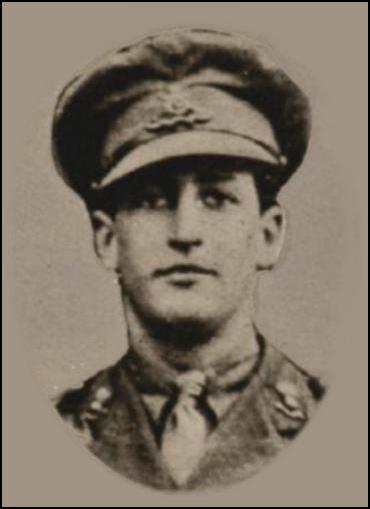 SYDNEY ARMSTRONG
SYDNEY ARMSTRONG
With
deep regret we record the death of Lieut. Sydney Armstrong R.F.C. which
occurred in the early hours of Monday morning Feb. 18th, while in the
performance of his duty. His remains were brought to the Church on the
following day, where they were received by the Rev. B.H. Durrant Field, and
were buried on Wednesday afternoon, February 20th, at 2.30 p.m. with full
honours, a full choir were in attendance, a firing party and bugler for the
Last Post. The bells were rung in half muffle. There was a great gathering of
airmen and sympathisers. Mrs. Armstrong and Miss Armstrong (mother and sister)
were the chief mourners. The service was conducted by the Rector and the Rev.
B.H. Durrant Field, all of which, except the “Commital” was taken inside the
Church. There were many beautiful wreaths. His age was 18 years.
Frederick Augustus Crowley
2nd
Lieutenant Royal Flying Corps. Died 26 February 1918. Aged 20. Son of Mathew
and Mary Crowley of Drigole, Bantry, Co. Cork, Ireland. Buried in St Peter’s,
Goldhanger Churchyard. There is more about Frederick Augustus Crowley in... Flight Station casualties
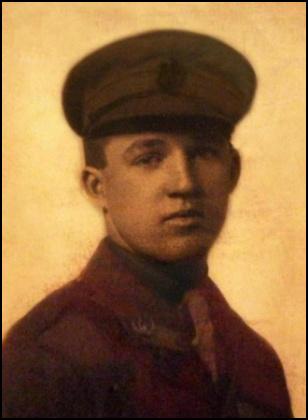
The
Parish Magazine of March 1918 records:
Obituary
FREDERICK AUGUSTUS CROWLEY
On
Tuesday morning, February 26th, at nine o’clock, Lieut. Crawley, R.F.C. met
with his death through his machine coming to earth in the performance of his
duty. He was buried in the Churchyard on Tuesday afternoon, February 28th, at
2.30 p.m. according to the Rites of the Roman Church, with full honours. His
age was 20 years, and his death was a heavy shock to us all, especially to
those whose painful experience it was to witness it. His home was in Ireland.
Dick Phillips
13th
Battalion Royal Fusiliers later Essex Regiment (probably after he was wounded).
Died on August 24th 1921, aged 22. Military Medal May 1916 for capturing
machine gun single handed. Bar two months later on the Somme. Buried in St
Peter’s Churchyard next to Walter Brewer.
Parish
magazine September 1921 records:
In Memoriam
DICK
PHILLIPS
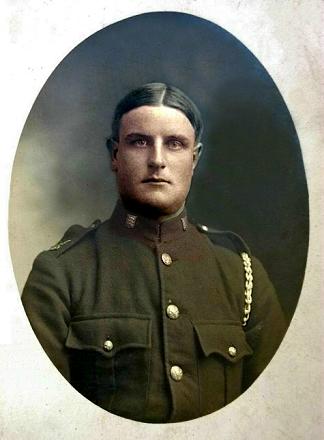 The
call to poor Dick came very sudden, and never for many years has there been
such an outpouring of sympathy and genuine sorrow as his death has elicited.
Yes, we say, poor Dick, because he would have loved to have lived on and to
have fulfilled his bright hopes in life, to have lived and loved and brought
sunshine into the lives of those near and dear to him, but God willed it
otherwise. His end was in full keeping with his life and he passed happily away
on Wednesday morning, August 24th, the Feast of S. Bartholomew.
The
call to poor Dick came very sudden, and never for many years has there been
such an outpouring of sympathy and genuine sorrow as his death has elicited.
Yes, we say, poor Dick, because he would have loved to have lived on and to
have fulfilled his bright hopes in life, to have lived and loved and brought
sunshine into the lives of those near and dear to him, but God willed it
otherwise. His end was in full keeping with his life and he passed happily away
on Wednesday morning, August 24th, the Feast of S. Bartholomew.
He
was a victim of the War, a proud victim, one of the many noble lives
sacrificed. The way in which he captured a German Gun, on August 23rd, 1918,
after his own had been put out of action, in a great advance, and turned it on
the retreating foe, after nearly all his own Company had been wiped out, which
won for him the proud distinction of the Military Medal, to which the bar was
added for a further fine achievement two months later, when with his machine
gun he practically saved his own Company from destruction and enabled them to
get back to cover are achievements which speak for themselves and are not
likely to be forgotten. But it was on November 4th in that year, in a further
attack that he was so badly wounded and had to be sent home.
Of
the nineteen men named on the War Memorial:
six are buried in the Churchyard,
seven
are buried overseas, four have no known
graves and two were lost at sea.
All
are named on battlefield and Royal Navy memorials.
Obituaries given in the Parish Magazines
of men whose names did
not appear on the original war memorial
and who were added to
the new plaque in 2014
Ernest Albert Belcher
The
Parish magazine for April 1917 records:
One
great support Mrs. Belcher and her daughters will receive in their crushing
sorrow is the knowledge of the depth to which it is shared by everyone, and
none, except those to whom the full circumstances are known can measure the
depth of the tragedy. He died in a Hospital, at Brighton, on Tuesday, March
6th, after a bare five weeks of military training in the service of his
Country. He left home on February 1st, to join the Royal Field Artillery and
soon contracted a serious illness which proved to be fatal. His loss came as a
heavy shock to all who knew him. As a member of the choir of so many years
standing, his loss will long continue to be felt.
His
remains were brought home for burial and were laid to rest, in the churchyard,
on Tuesday afternoon, March 13th, at 3-30, the last offices being performed by
the Rev. B.H.D. Field and the Rev. H.F. Pattison. The Rector was not well
enough to attend. The members of the choir were present and a very large
gathering of sympathisers and friends. Mr. Kirby at the organ played “The Dead
March”, and hymns, “God moves in a mysterious way”, and “There is a Blessed
Home”. Among the many wreaths was one from the choir. His age was 28 years.
R.I.P.
Thomas Woolford
The
Parish magazine May 1915 records:
Till
lately one of our coastguards, at the outbreak of war was called up, and went
in the North Sea for four months on the “Royal Arthur”. He then was sent aboard
an armed liner, the “Clan McNaughton”, and left Liverpool on Jan. 23rd, nd the
last time she was heard of was Feb 3rd. The Admiralty have lately given notice
that she has been lost with all hands, how and when is not known. His high
character made him a general favourite with all here, and we mourn his loss and
our deep sympathy goes out to Mrs. Woolford in her heavy affliction.
Thomas
Woolford was the second Goldhanger man to lose his life in the Great War and
the 3rd of February 2015 was the 100 year anniversary of Thomas's death. To
mark the occasion the bells of St Peters were rung at noon on that day. Hear
the bells at...
Thomas Woolford's 100th year
aniversary
Obituary in the Parish
Magazine of a fatal accident at the Flight Station...
William Quintus Newsom Richardson
2nd
Lieutenant Royal Flying Corps. Died 6 October 1917. Buried in Grave 42. 54. at
Maldon Cemetery.
The
Parish magazine for November 1917 records:
“on
Saturday, Oct. 6th, in the afternoon about 4 o’clock, the first fatal accident
at the Air Station occurred here, when a new-comer, Lieut. Richardson, who had
only been on the Station about 24 hours, was upon a practice flight, and his
machine fell to the ground from no great height, as the result of a sideslip.
Death appears to have been instantaneous and the machine was wrecked.”
The
Rector wrote a letter of sympathy to his bereaved mother (a widow) in behalf of
himself and the people of Goldhanger, which was acknowledged with grateful
thanks. His remains were taken to Maldon for burial. He was 19 years old.
Several
short extracts follow from the many detailed reports in the Parish magazines of
the time, recording the fund raising, planning, building and dedication of the
memorial…
Parish magazine December 1918:
Our Fallen
A
meeting was held at the Rectory on Thursday afternoon, November 14th, of the
Parents and Relatives of those who have been killed in the War. Everybody
attended except Mr. and Mrs. Hover, Mr. and Mrs. Lewis, prevented through
illness. The Rector (Revd Gardner) presided, the object of the meeting was to
consider the erection in the Churchyard, in front of the Tower, of a suitable
Memorial. The meeting opened with Prayer. Various designs were considered. All
were unanimous in adopting a representation of the “Great Sacrifice” to be
executed in stone and about 20 feet in height, which it is hoped will be
completed next July, and which it is their intention to erect.
The
Rector, in the face of the splendid record of Goldhanger in the War, has
applied to the Authorities for the grant of a German Field Gun to be placed in
front of our Parish Memorial which is to be erected in front of the Church
Tower. We hope the response in money will be generous from everybody towards
our Memorial. It may then be possible to have new wide gates and a wide path
from the road to the Tower, to place the Memorial in the centre of the path,
and with the Gun in the foreground if granted would be a noble completion.
see newspaper articles in. . . Plans
from the past - captured field gun
Parish Magazine July 1919:
The War
Memorial
If
some generous contributor who possibly may not so far have subscribed at all,
or only given a small contribution, were to offer to pay for the inscription of
the names on the War Memorial, then the total sum required will have been
either promised or given. It is a noble and wonderful performance on which we
may well congratulate ourselves. A further sum is, however, required in order
to commemorate, either by means of a tablet in the Church or in some other way
the names of all those who went forth from this parish in order to defend their
country in her hour of peril. Their names should never be forgotten. The
foundations for the Calvary are to be laid at once, and it may be erected
before July is out. Its design, which has been so much admired for its suitableness
and beauty, is now being included in an exhibition of memorials in South
Kensington Museum. The final sum raised was ₤394.
Parish magazine August 1919:
Peace
Rejoicings
The
Village was in full holiday garb on Saturday, July 19th, the streets were gay
with flags and streamers, and the Church bells rang joyous peals. There were
sports for children and adults in the Rectory grounds, and the returned
soldiers, about 30 in number, were entertained to a capital dinner.
The
Memorial is up – and very beautiful it is. The names are inscribed in Gothic
lettering in keeping with the Gothic design of the Memorial. They are placed on
three panels and add greatly to the enrichment of the Cross.
Parish magazine August 1920:
Dedication of
the War Memorial
Friday, 25th July, will be a day never to be forgotten
in the annals of Goldhanger.
It
was the day set part for the Dedication of the magnificent War Memorial erected
in the Churchyard to the memory of the brave men and boys of this Parish, who
nobly sacrificed their lives in the Great War. The Lord Bishop of the diocese
preached an eloquent and impressive sermon after which he dedicated the stained
glass window placed in the south wall of the Church to the memory of John
Wakelin, who was killed in action. Then the Choir, preceded by the Cross and
followed by the Clergy and Bishop, walked in procession and took up their
places in front of the Memorial. A number of our soldiers, under the command of
Chief Coastguard H. Hover, acted as a guard of honour on three sides of the
Memorial.
A
special form of prayer was used and Psalm 130 was said. The hymn “When I survey
the wondrous Cross,” was sung with much feeling, and the Memorial was dedicated
by the Bishop to the Glory of God and in Memory of the men of this Parish who
had fallen in the Great War. The Bishop addressed the large congregation
present, after which the hymn, “Abide with me” was sung and the memorable
service concluded with the Benediction of the Lord Bishop.
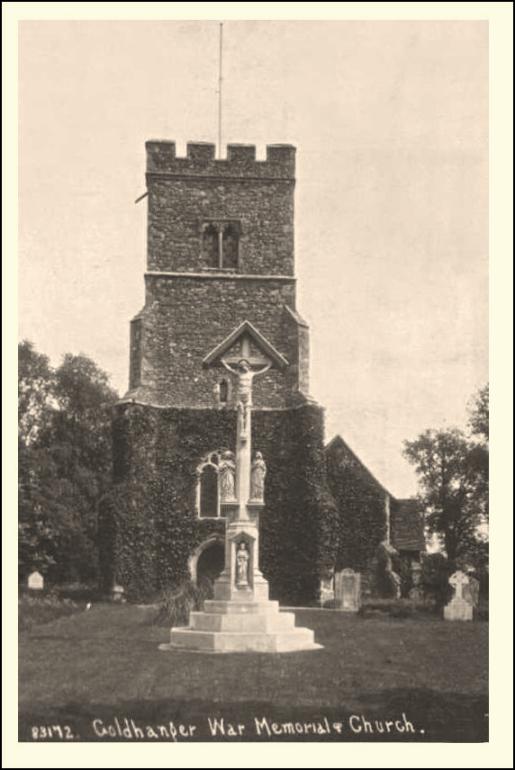
A postcard image of the War Memorial as it appeared at
the time of the dedication
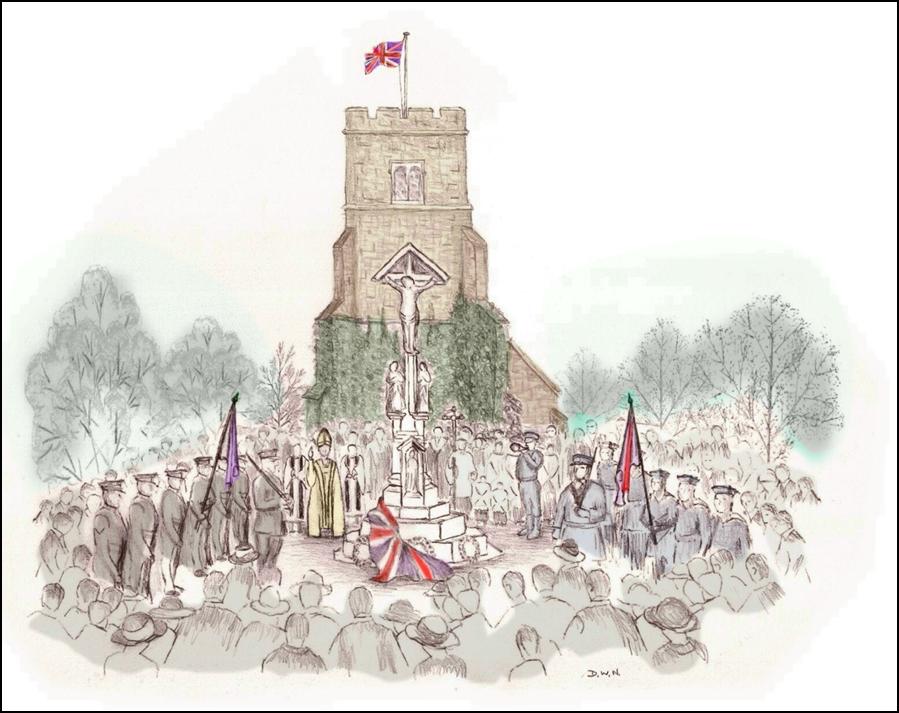
an artist’s impression of the dedication ceremony.
No photograph has been seen of this event,the sketch
is based on the Parish Magazine article above
and photos of similar dedication ceremonies held
elsewhere.
zoom in on a high-definition image of the Memorial as it
appears in recent years
|
Listen to the dedication hymn: |
|
In the Parish Magazine of July 1919 the Rector wrote:
“A
further sum is, however, required in order to commemorate, either by means of a
tablet in the Church or in some other way the names of all those who went forth
from this parish in order to defend their country in her hour of peril. Their
names should never be forgotten”.
It
appears that this tablet was never produced, or at least is not now to be seen
anywhere in the Church, so in 2008 as part of the research into the involvement
of the village in the Great War this “Roll of Honour” was produced...
The Great War Roll
of Honour
( as recorded in Goldhanger parish magazines and elsewhere ) |
|
||||||
|
George Walter T Alfred Alfred W Ernest Ernest Herbert Bertie Fred Sidney Walter Albert Percy Harry Thomas Samuel Arthur Bertie |
Abbott Abbott Angier Appleton Askew Barbrook Belcher + Brazier + Brazier Brewer Brewer Brewer + Brewer + Chaplin Chaplin Clark Coker + Crowland Everett Everett |
Ernest Crawshay Willie Cyril Henry Leonard Lionel William William George Henry Jon Samuel Fred Harry Bertie Percy Ernest Stanley James |
Everett + Frost Frost Gardner + Hover Hover Hover+ Hume + Hummerston + Johnson Johnson + Johnson Johnson Lewis Lewis + Lynn Mann Mansfield Moss Norton |
Frank John Ernest Dick Walter Harry Percy James William Charles Sidney Arthur Charles Samuel Walter John Richard Henry Albert Thomas James |
Owers Owers Phillips Phillips + Phillips Pennick + Prior Seaborn + Seaborn Smith Smith Sparkes Stokes Ruffle Wager Wakelin + Wakelin Ware Wallace Woolford + Youngs |
|
|
200 men were listed as residents in the 1911 census
60 were known to have served in the war
+ these 17 were killed in
action + |
|
||||||
There were
many other Parish
Magazine reports of Great War related activities in the village at the time.
From the East Anglian Daily Times of June 1939:
“Partly
because of the tower, the building seems singularly striking, and is rendered
even more so by a stone Calvary facing the village, an affair impressive and
noble of aspect, which is Goldhanger's memorial to the men of the parish. . . “
Commemorating the 100th anniversary of the start of the Great
War
and the addition of a new plaque on the War
Memorial
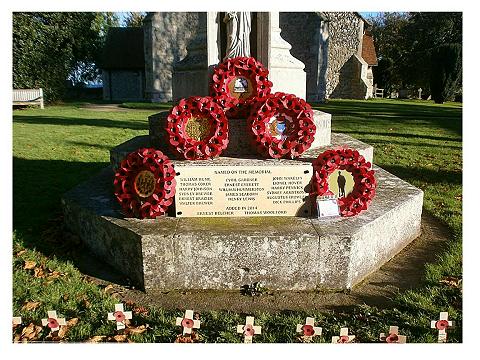
To commemorate of the 100th anniversary of the start of
the Great War special events were organised in the village over “Remembrance
Weekend” on the 7, 8 & 9th of November 2014. The details of this event are
at... Commemoration of
the 100th anniversary
The Goldhanger Red Cross
volunteers during the Great War are identified in... https://vad.redcross.org.uk
Registration cards for each
are available, but there is little more information on them. Here is a summary...
|
|
|
||
|
|
Goldhanger
Red Cross volunteers
during the Great War |
||
|
|
Mrs Barbrook, Head
St |
Miss
Connie Francis, Head
St |
Mrs.
(Thomas) Taber, Follyfaunts |
|
|
Mrs Boyess, Head
St. |
Miss
Angela Gardner, The
Rectory (Rector’s daughter) |
Mrs (Arthur) Taber, Falcon
Hall |
|
|
Mrs Kate Buckingham, Rectory
Cottage, Maldon Rd |
Mrs Ethel Gardner, The
Rectory (Rector’s wife) |
Mrs Ellen Turner, Head
St |
|
|
Mrs Bunting, Highams
Farm |
Miss
Huxter, Maldon
Rd |
Mrs Ware, Church
St |
|
|
Mrs Clark, Fish
St |
Mrs Johnson, Church
Street |
Mrs W. Wenden, The
Post Office, Head St |
|
|
Samuel
Crowland 30yrs
old, ambulance river |
S.
A. Moss 19yrs
old, ambulance driver |
Mrs E. White,
Church
St |
|
|
Miss
Hylda Easton, The
Rectory (Rector’s employee) |
Mrs Everett, Maldon
Rd |
Mrs Norton, Maldon
Rd |
|
|
Miss
Lizzie White, Fish St |
Mrs Francis, Head St |
Mrs Sparke, Head St. |
|
|
Mrs.
(John) White, Fish St |
Mrs.
Willsmore |
|
|
|
|
|
|
The Goldhanger Flight Station
In
August 1915 Goldhanger was chosen as a suitable location to intercept Zeppelins
en route from Germany to London as they were known to be flying up the
Blackwater Estuary. In his published diary, local GP Dr Salter made 32
references to Zeppelins passing overhead in the area between 1915 and 1916.
Initially it is said that just one bi-plane was stationed Gardners Farm, with
the pilot given “bed & breakfast” at the farmhouse. The first hangar
arrived in 1916. The Name “Flight Station”, given by The Royal Flying Corps,
was derived from it having only one flight located there. The Royal Flying
Corps later became the Royal Air Force, with 37-Squadron stationed at Goldhanger,
when it became know as Goldhanger Aerodrome. It was absorbed into 39-Squadron
in 1919 which was finally disbanded in 1957. The Station closed down in March
1919. There is no visible trace left today of the Flight Station to indicate
that there was once a operational airfield within a mile of the village. It was
located alongside the B1026, on the south side of the road close to the
seawall, in fields that still belong to Gardener's Farm. Today there is a farm
shop on the field.
To
commemorate of the 100th anniversary of the opening of the Flight Startion a
plaque has been installed at the location and a special event was organised in
the Village Hall close to the 2015 Remembrance Day. See... Zeppelin
Busters over the Blackwater
Goldhanger
Flight Station was closely linked with Stow Maries and Rochford Flight
Stations. Their headquarters was at The
Grange on the Southend Rd. at Woodham Mortimer. Many comparisons have been
made between the three sites: Stow
Maries was largely constructed of brick buildings which have survived, whereas
the buildings at Goldhanger were mostly of wood and have not survived. However,
it seems Goldhanger was the most active of the three with about 50% of
operational flights in 1917, 33% from Stow Maries and 17% from Rochford, In Fields
of the First written by A Doyle and published in 1997 the 4-page
description of the Goldhanger Flight Station includes a comparison is make
between the personnel and facilities…
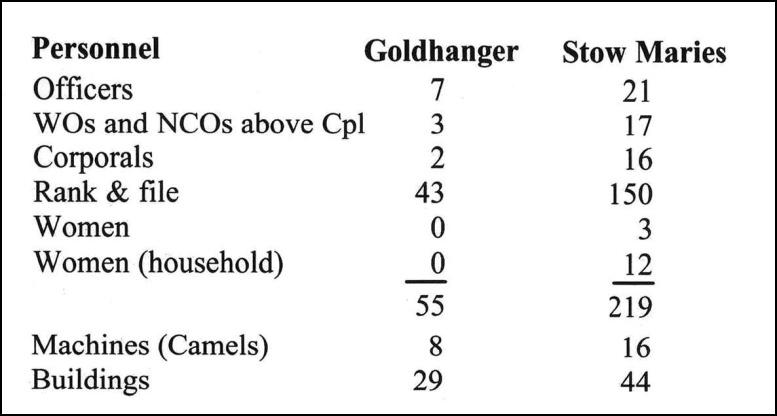
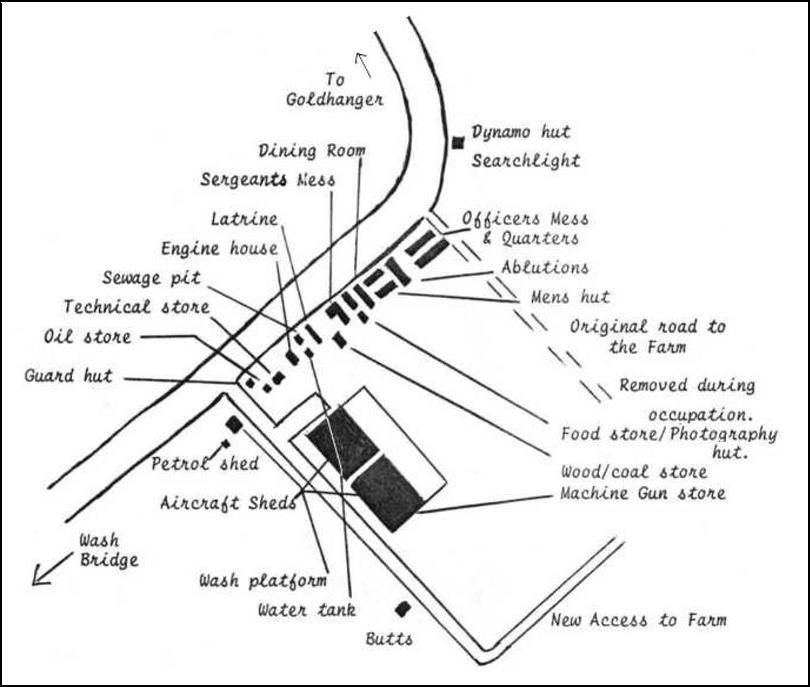
map showing the layout and buildings at Goldhanger
Flight Station
artist’s
impression of the airfield - select
to enlarge
Some
29 structures were built on the western edge of the aerodrome site including
four aeroplane sheds. In October 1919 the Ministry of Munitions offered of all
the buildings on the site for sale. However, the four aeroplane sheds survived
on the site until 1922 when, after being purchased by May & Butcher of
Heybridge Basin, two were sold on to Crittall's for their factories at Silver
End and Witham and were used as a canteen and store. When that business closed
in the 1990s, and having been in use for some 74 years, they were acquired by
the Brooklands Museum at Weybridge where they remained unused until they had to
be destroyed due to rot. They are circled in red on these 1930s aerial
photos...
at Crittall's site in Witham
at Crittall's site in Silver End
In
the 1920s the Bentall’s agricultural engineering
company at Heybridge acquired two WW-1 hangers, which almost certainly came
from Goldhanger. They were re-erected on the Bentall site, but was never
effectively used and became known by the workers as “The White Elephant”. They
was removed and replaced by a new foundry building in 1949.
The former Goldhanger
hangars on the Bentalls site at Heybridge in the 1930s (in the red circle)
May
& Butcher purchased many of the wooden buildings from both the aerodrome
and from HMS Osea and sold them on. In 1920 the Bentall family acquired the
Sergeants Mess hut from the aerodrome site and installed and commissioned it in
Heybridge Basin as St Georges Chapel in memory of their son who was killed in
the war, where it remains today...
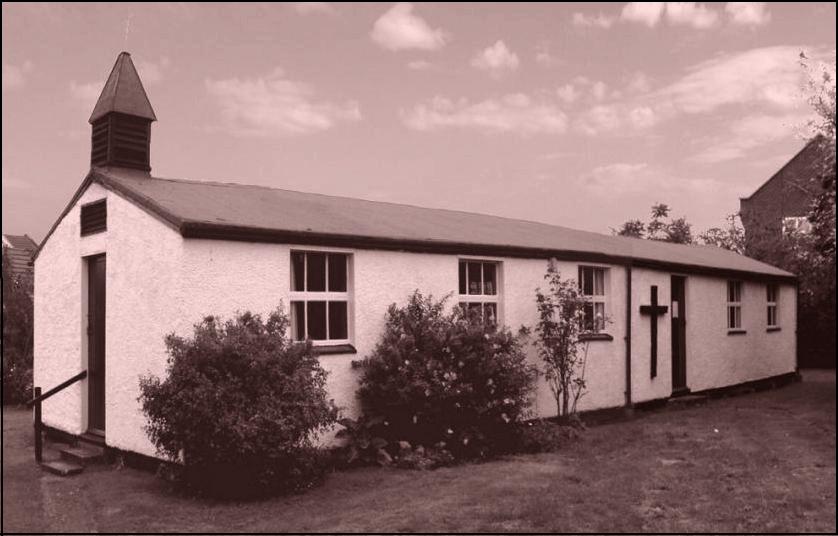
St Georges Chapel,
Heybridge Basin, formerly the Sergeants Mess
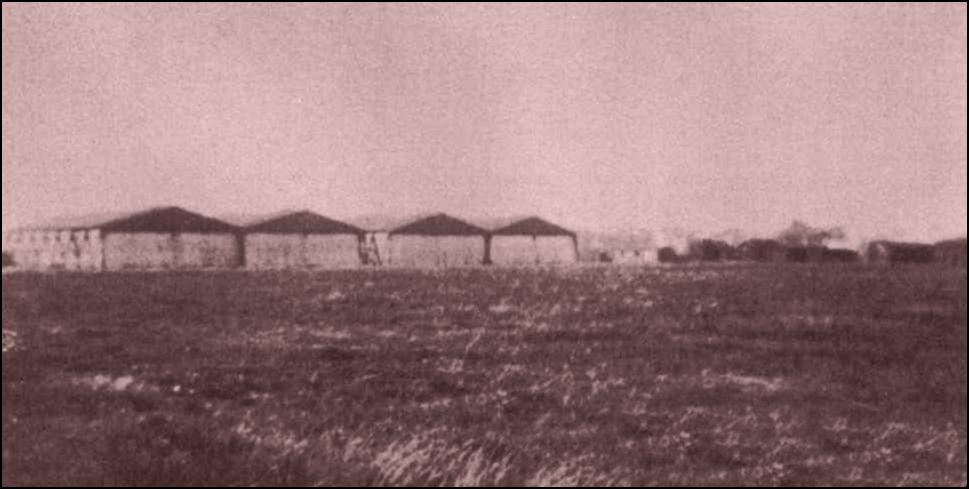
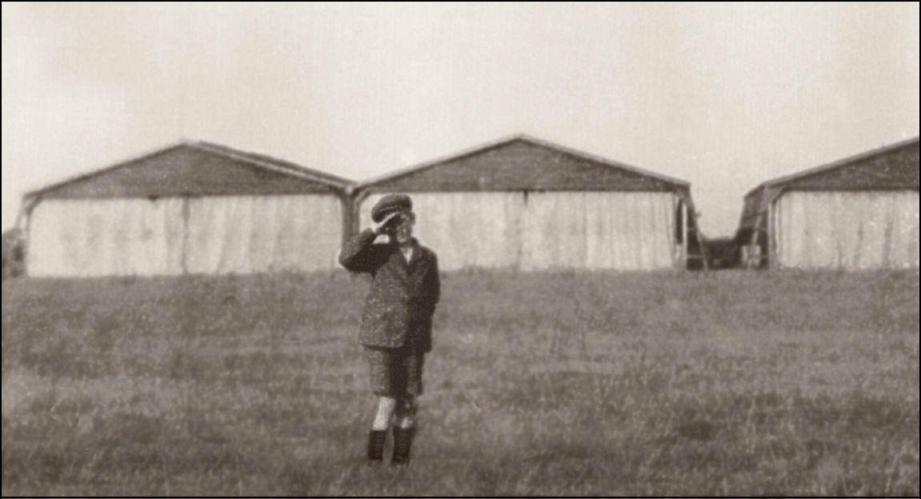
The hangars at
Goldhanger.
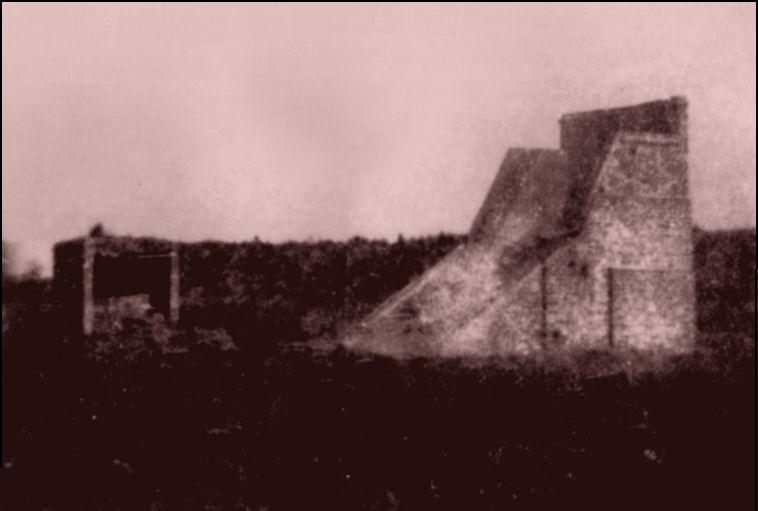
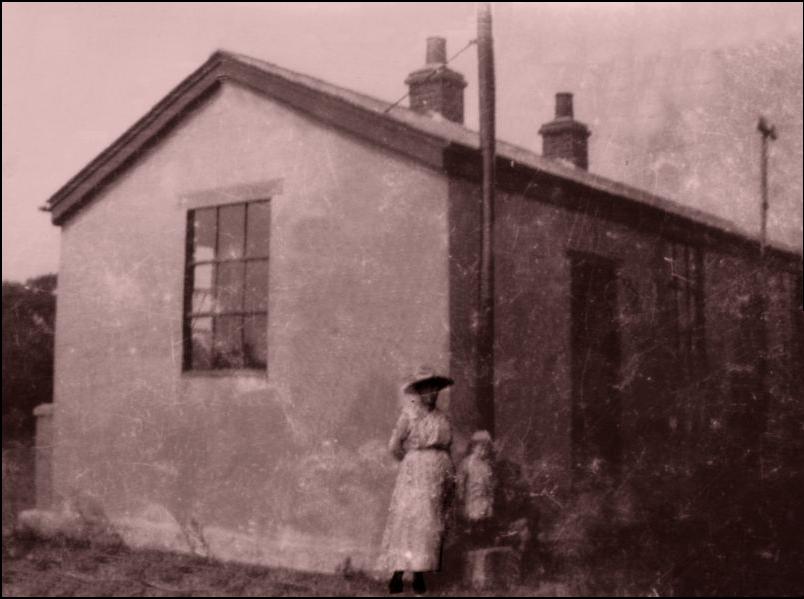
Shooting
Butt at
Goldhanger the
Guard House (last remaining building)
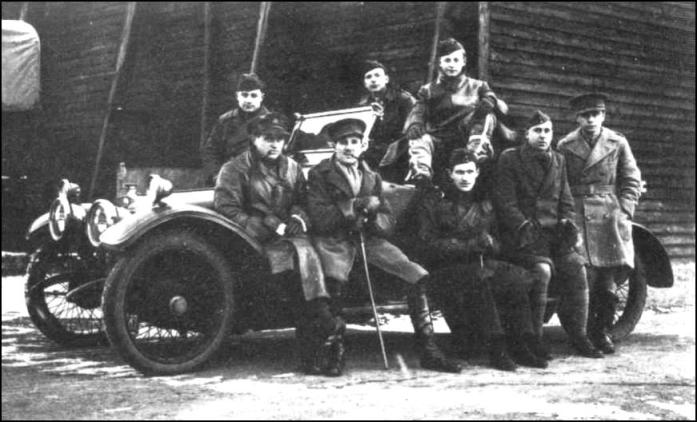
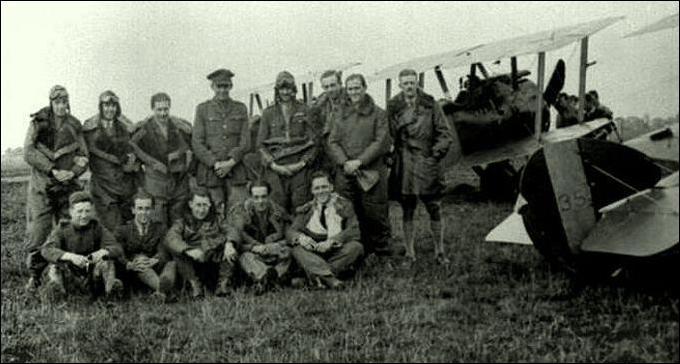
No.37 Squadron pilots stationed at Goldhanger - those
mentioned on this page are probably in these photos
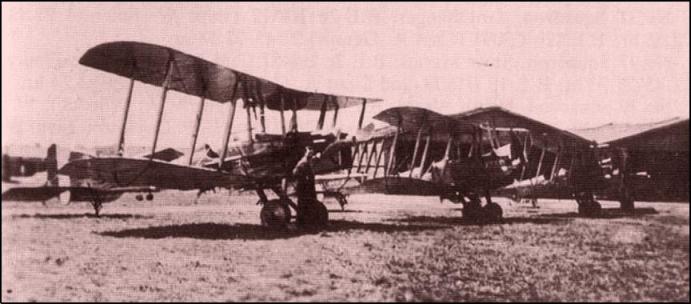 ....
....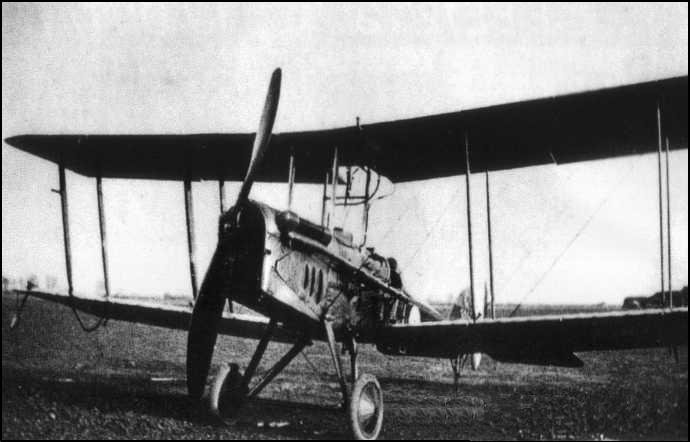
BE12s at Goldhanger
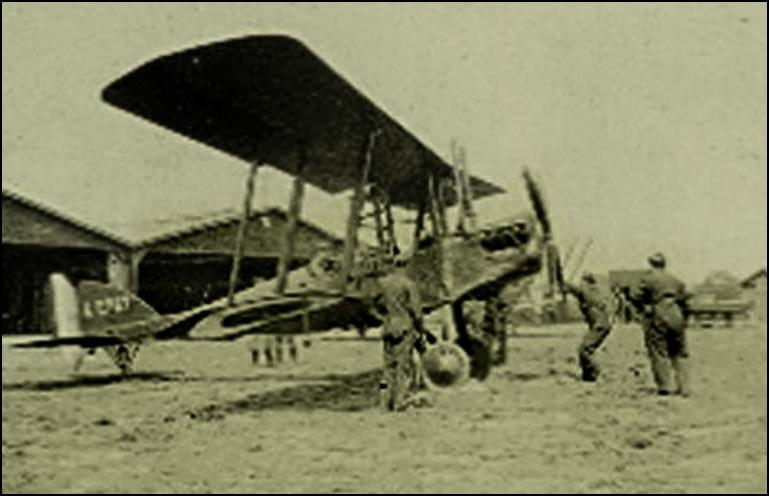
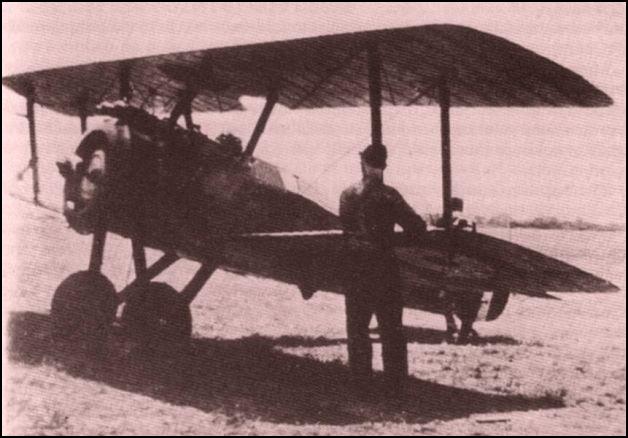
BE2e
at
Goldhanger Sopwith
Camel at Goldhanger
|
From log books we know At least 11
different types of aircraft were based at Goldhanger at different times,
although there were thought to be never more than 8 aircraft based there at
any one time. By comparison with Zeppelins these bi-plans were remarkable
small fragile machines. They struggled to reach the altitude of the
Zeppelins, and pilots had to cope with both sub-zero temperatures and a lack
of oxygen. The aircraft had open cockpits, no radios, no brakes, no flaps and
no parachutes! Most had 80 horse-power engines with fuel for only 2 hours
flying time. To overcome the problem of short flying time, a series of Night Landing
Grounds with minimal facilities were created: mowed grass strips,
landing flares, a fuel tank and a shed with a telephone.
Select this image to enlarge
it... |
||
|
The FE-2
was designed at the Farnborough Aircraft Factory and 'FE' stood for 'Fighting or Farman Experiential', but despite the name they had a major role as Zeppelin chasers
during the war. Over a 1000 were built and 200 were used for Home Defence.
Similarly, the 'BE' in 'BE-2' stood for ' Bleriot Experiential', a de Havilland designed machine, of which over 3,500 were built by
20 manufacturers. There is a 1-minute silent film of an FE-2
being moved out of ' sheds' which are remarkably like those once at
Goldhanger (but it probably wasn't filmed at Goldhanger), which can be seen
at... Youtube.com
- Royal Aircraft Factory FE2 Today, with many restorations and
reproductions of these WW-1 biplanes we can now see high definition close-ups
of them in full colour, both on the ground and in the air, which was not
possible in the early 1900s due to the limitations of photographic technology
at that time. Select this image to view the high definition photos and zoom in... |
||
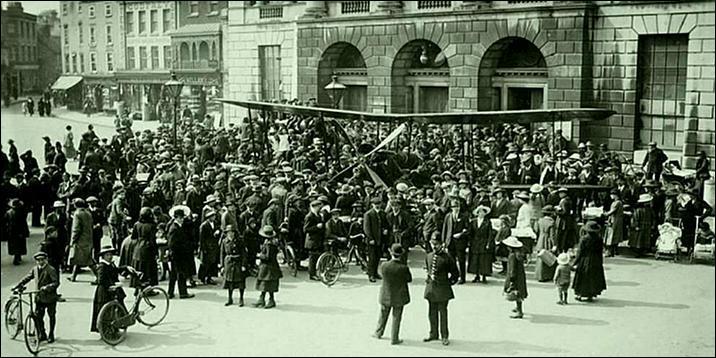
BE-2 from Goldhanger Flight Station in the centre of
Chelmsford during Aeroplane Week in 1918
Incidents recorded at
Goldhanger Flight Station...
Captain Frederick Sowrey,
who was based at Goldhanger, was awarded a DSO after he shot down Zeppelin L32
at Billericay in Essex having taken off from Sutton Farm on the 23 September
1916. His final tally was twelve victories other than the L32, six enemy
airplanes destroyed and six driven down out of control and was finally awarded
the Military Cross.
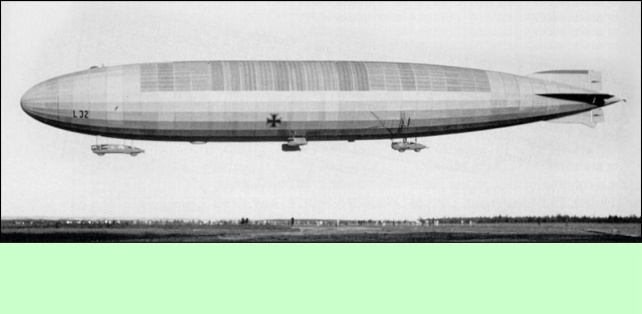
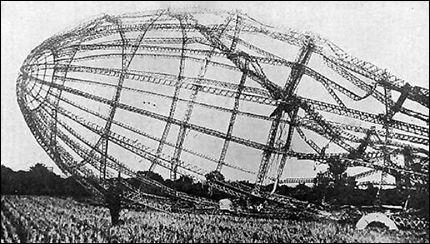
Zeppelin
L32 L32
at Billericay
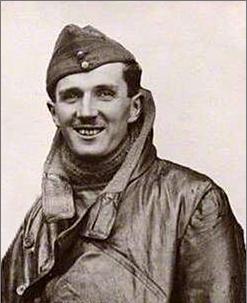
Captain Frederick Sowrey DSO, MC,
AFC
Second Lieutenant L.P. Watkins was
involved in one of the most notable patrols from Goldhanger which occurred on
16/17 June 1917 when he took off in B.E.12 to pursue a Zeppelin returning from
a raid on London. Loudon Pierce Watkins was a Canadian citizen. The L48
Zeppelin was attacked near Orfordness and Second Lieutenant Watkins was
credited with shooting down the airship which crashed at Holly Tree Farm, near
Theberton, Suffolk and was awarded the Miltary Cross. All but three of the
seventeen crew perished, and it was the last airship to fall on English soil.
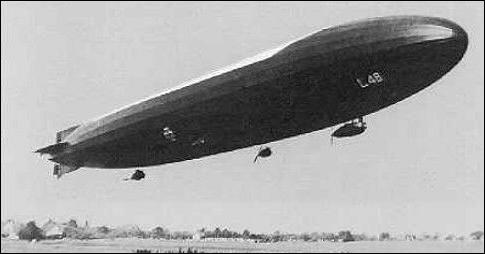
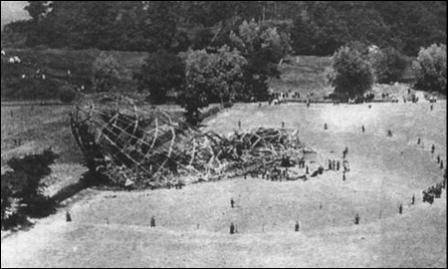
Zeppelin
L48
L48
at Theberton
In
1918, at the age of 21, Captain Loudon Pierce Watkins was killed in action in
France and is buried at Ligny-St. Flochel British Cemetery, Pas-de-Calais...
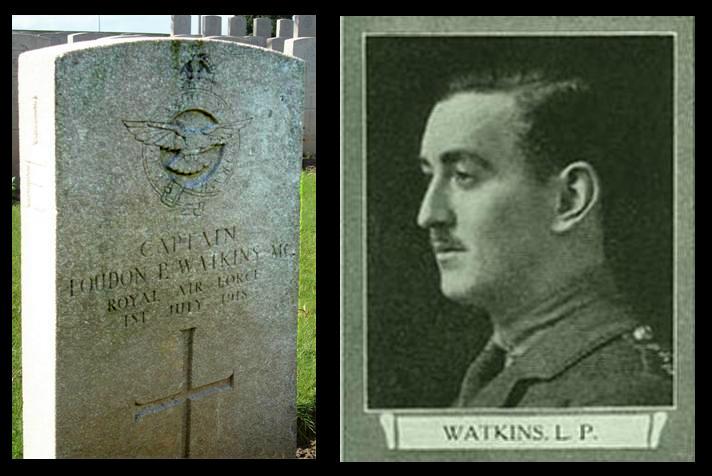
It is not
known what significance this piece of Marconi history has to Loudon Pierce
Watkins and Goldhanger…

...however,
Zeppelin L48 is clearly shown on this BT phonecard. More at...
Marconi WW-1 Direction Finders
Captain Arthur Dennis
On
the 29th of January 1918 Captain Arthur Dennis of No37 Squadron at Goldhanger
made an emergency landing in the field beside the Canal at Heybridge Basin...
Capt. Dennis’s BE-12 in a Heybridge field
Captain
Dennis had intercepted a German Giant bomber in an unsuccessful attack with a
fellow No37 Squadron pilots. His plane was damaged and he made emergency
landing in this field. Here is an extract from No37 Squadron operational
records...
Captain Arthur Dennis
a set of operational records for 32
sorties of 37 Squadron at Goldhanger between 1917 & 1918 are here...
Operational
Records (13-page PDF file)
Major Mick Mannock VC, DSO, MCO as
the flight commander of the newly formed No. 74 Squadron flew his Squadron to
Goldhanger aerodrome in March 1918 on route to Ypres, and he wrote to a friend:
“Our three days at Goldhanger were due to an air-raid scare, bur we neither saw
nor heard any enemies there. Our brief stay in this cheerless spot was
enlivened the night before we left by a little excitement caused by the great
big chief of the village (thought to be Dr Henry Salter,
who was the “Chief Special Constable” for the area) who objected to the
Squadron singing some of the renowned R.F.C. songs in the Chequers
Inn“. Major Mannock resented the intrusion, and offered to throw out the
big noise but gave him the alternative of staying and accepting a drink. The
Arm of the Law fortunately saw the funny side of the offer and chose the drink.
The next day Mannock and his pilots, some more than likely still “hung over”,
left for France. Many of them did not come back. Major Mannock himself was shot
down and killed between Calonne and Lestreme in the July. He won the Military
Cross twice, was one of the rare three-time winners of the Distinguished Service
Order after shooting down 20 German planes in May 1918, four of them in one
day. He was posthumously awarded the Victoria Cross and is still regarded as
one of the greatest fighter pilots.
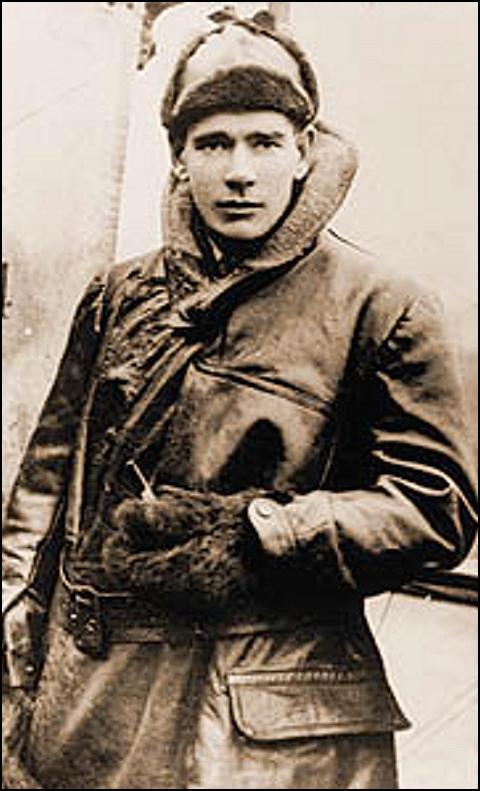
Major Mick Mannock - “the highest scoring WW1 Ace with at
least 75 kills”
The four pilots from No.37
squadron at Goldhanger lost their lives during the war. . .
Sydney
Armstrong
In February 1918 Second Lieutenant Sydney
Armstrong suffered engine failure in his BE-12 while attacking a Giant R.25
bomber. He had stopped over at the Easthorpe Night
Landing Ground, but then crashed between Tolleshunt Major and Goldhanger.
He is buried in a military grave in St Peter's Church Goldhanger. His name is on the Goldhanger
War Memorial. The Flight Station log recorded: On the 17/18 Feb. 1918 there was a single Giant
raid on London. 69 UK planes were involved with 4 from Goldhanger. 21 were
killed & were 32 injured in the raid. One of them was 2nd Lt. Sydney
Armstrong who was killed when his engine was damaged and he crashed in a
field between Goldhanger and Tolleshunt Major. The log also recorded: “It is
believed that Lt. Armstrong intercepted Giant R.25 and the engine of his
aircraft was damaged” |
|
|||
Frederick
Augustus Crowley
|
||||
|
|
Also in February 1918 Second Lieutenant Frederick
Augustus Crowley crashed in his Sopwith Camel in a field in the centre of
Goldhanger close to the Cricketers Inn. He is also buried in military grave
in St Peter's Church and his name is on the Goldhanger War
Memorial. |
|||
|
Here is
what Maldon historian Stephen Nunn has written about Frederick Augustus
Crowley... Freddie Crowley was born in 1898 in the
remote village of Adrigole in south-west Ireland and was ready for “the Great
Adventure” and although as an Irish citizen he didn’t have to serve in the
war, he was keen to “fight the Hun”. Initially serving in the Royal
Engineers, in 1918 he transferred to the newly formed Royal Flying Corps.
Flying, let alone aerial combat, was in its infancy and it is incredible to
think that a young man, from such a far-away place, both physically and
progressively, should end up flying aircraft. He was appointed Second
Lieutenant and allocated to 37 (Home Defence) Squadron. The Squadron’s brief
was to defend London and the English East Coast from German air-raids. Three
flight stations were established at Rochford, Stow Maries and Goldhanger.
Freddie was sent to ‘C’ Flight, then on the outskirts of the little saltwater
village of Goldhanger. Just a few days beforehand the Flight had
lost a pilot and Second Lieutenant Crowley was to be his much needed
replacement. One can imagine him arriving at the Guard Hut that day and being
directed to the Officer’s Quarters. I wonder how the inexperienced,
fresh-faced lad with a broad Irish accent, was received ? It was the evening
of Sunday 24th February 1918 and, being the Sabbath, his thoughts were
doubtless with God and his family back in Adrigole. He may even have taken
some comfort in his well-thumbed Rosary. Flying practice would have started
in earnest the following day. It continued first thing on the Tuesday and,
just before 9 o’clock, Freddie took off in his BE2 and headed towards the
village centre. It was then that something went terribly wrong. The official
RFC report simply states that Freddie “lost his head”. An eyewitness said
that they saw the aircraft had clip some trees. We will probably never know
what actually happened that spring morning all those years ago. It was long
before the days when air incidents were subject to any kind of detailed
analysis. Pilot error was doubtless the inevitable conclusion, especially as
he had only three lots of fifteen minute solos in his log book. The BE2
stalled and came down to earth in a sickening crash in a field to the rear of
‘The Cricketers’ pub. Fire broke out and the first person on the scene was
the village blacksmith. He did his best to recover Freddie but was beaten
back by the flames. Freddie’s body was taken to Goldhanger
vicarage and a Catholic priest from Maldon arrived to administer the last
rites. His funeral took place on Thursday, 28th February 1918. The procession
set off from the aerodrome and his coffin was drawn to Goldhanger church on a
gun carriage. Being a Catholic, the service was not allowed in the church,
but was conducted outside in the graveyard at 2.30pm to the sound of muffled
bells, “according to Roman Rites” and with full RFC honours. Meanwhile the dreaded War Office telegram
arrived at the little Post Office at Adrigole. It was accompanied by the
charred remains of what was thought to be a Rosary. Just four weeks later a
fellow Irishman called in at the Goldhanger ‘Chequers’ for a good drink
before his onward flight to the Western Front. Although he was also a
Catholic from County Cork, he was very different to Freddie. Mick Mannock was
a flight commander, an ace, who would go on to receive the Victoria Cross, but
like Freddie, he too would make the ultimate sacrifice. Did anyone tell him
about that earlier tragic loss? Did he go and stand by the freshly dug clods
of Essex soil and think of their mutual homeland? Did it make him wonder what
it was all for? Next time you are in Goldhanger go and look Freddie up. You
can’t miss his Commonwealth War Graves’ headstone. It looks so different to
all the other memorials, that is except for one other to the pilot that he
came here to replace, Second Lieutenant Sydney Armstrong. The two airmen lie
together, perhaps not in a foreign field, but somewhere very different to
Frederick Augustus Crowley’s birthplace. They deserve to be remembered for
what they did for us, after all they have become Goldhanger’s adopted sons. |
||||
William
Quintus Newsom Richardson
|
||||
|
2nd Lieutenant Royal Flying Corps. Died 6 October
1917. The Parish magazine for November 1917 recorded: “On Saturday, Oct. 6th, in the afternoon about 4 o’clock,
the first fatal accident at the Air Station occurred here, when a new-comer,
Lieut. Richardson, who had only been on the Station about 24 hours, was upon
a practice flight, and his machine fell to the ground from no great height,
as the result of a sideslip. Death
appears to have been instantaneous and the machine was wrecked.” The Rector wrote a letter of sympathy to his
bereaved mother (a widow) in behalf of the people of Goldhanger, which was
later acknowledged with grateful thanks.
William Richardson was 19 years old, and photograph has been found.
His remains were taken to Maldon Cemetery for burial at Grave 42 54 There
is more about William Richardson at... |
|
|||
|
www.lincstothepast.com/RICHARDSON--William-Quintus-Newsom/1561615.record?pt=S |
||||
Alexander
Bruce Kynnock
|
||||
|
|
Capt. A B Kynnoch (or Kynoch) was born in Essex
in January 1894. On the night of March 7/8, 1918 he took-off from Goldhanger,
in a BE.12 to do battle with six invading Gotha bombers. During the
engagement he collided with an SE.5a flown by Captain H C Stroud from 61
Squadron at Rochford, and entangled together, The two aircraft fell to the
ground, crashing near a railway line at Shotgate, Essex. Both pilots were
killed and are remembered by two memorials at the site. Captain Kynnock's final resting place is in the
St Pancras and Islington Cemetery in north London. He was awarded the 1914
Star, the British War Medal and the Victory Medal. There is more about Alexander Kynnoch at... http://www.37rfc.org/page17.html (then scroll down the page a liitle) |
|||
|
|
||||
these officers
graves are maintained by the War Graves Commission

The memorial at
Stow Maries unveiled in 2000 identifies the four airmen stationed at Goldhanger
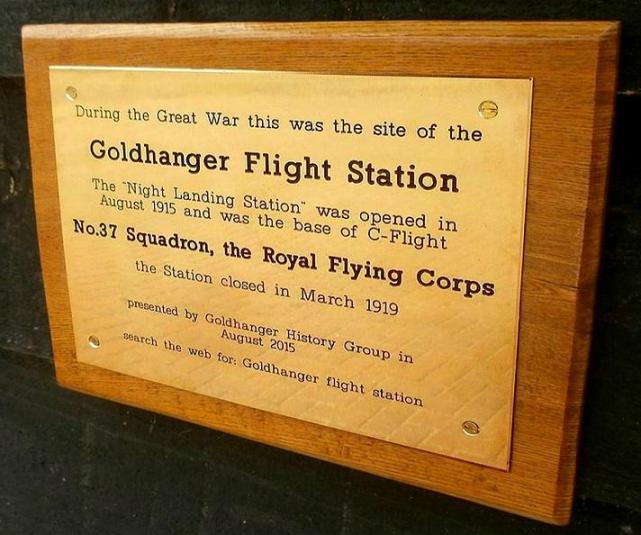
Brass plate
unveiled at Gardeners Farm in August 2015
See also... Zeppelin Busters over the Blackwater
and... 37-Squadron Night Landing Grounds
HMS Osea
Although
not part of Goldhanger Parish, the story of Goldhanger’s involvement in the
Great War would not be complete without including the history of HMS Osea,
which was just across the estuary on Osea Island. Also several Goldhanger
residents worked at HMS Osea as civilians which they described in a BBC TV
programme recorded in 1981 and available on YouTube at... Osea Island
Reminiscences. A very large naval
base was established there with all the facilities for the operation of a fleet
of high speed motor torpedo boats called ‘Coastal Motor Boats’ and well known
as CMBs. Work became in 1917 using existing facilities built by Frederick Charrington as a retreat for those
suffering the effects of alcohol.
The
new occupants rapidly developed and expanded the site into a base for over 1000
personnel with 40 operational boats and all the support facilities. In fact,
military involvement with Osea Island had started as early as 1913 when trials
of prototype seaplanes were held there. See… Estuary
Activities - Seaplane trials. The CMBs were designed and initially built by
Thornycroft Ltd. but during WW-1 production of the wooden boats took place in
several boat yards. Judging by the scenes of the HMS Osea workshops in this IWM video
on the Island it would seem that final assembly of the boats and fitting of the
torpedoes took place on the island.
CMB from HMS
Osea at speed
model and section drawing of
a CMBs
The
purpose of the base was kept very secret at the time but the CMBs, or “skimmers”
as they were called locally, were very active on the Blackwater Estuary
practicing and developing their skills and plans to take on the German fleet.
In total 40 Coastal Motor Boats from the base patrolled the North Sea searching
for German submarines and small naval vessels and laid mines. They also took
part in famous raids on Zeebrugge and Ostend when the Royal Navy attempted to
block the entrances to the German submarine bases there.
The
torpedo was launched from the rear of the CMB by being hydraulically pushed out
the back, so the boat had to do a rapid 180 degree turn to avoid being hit by
its own weapon! There were no reports of deaths resulting from getting this
manoeuvre wrong.
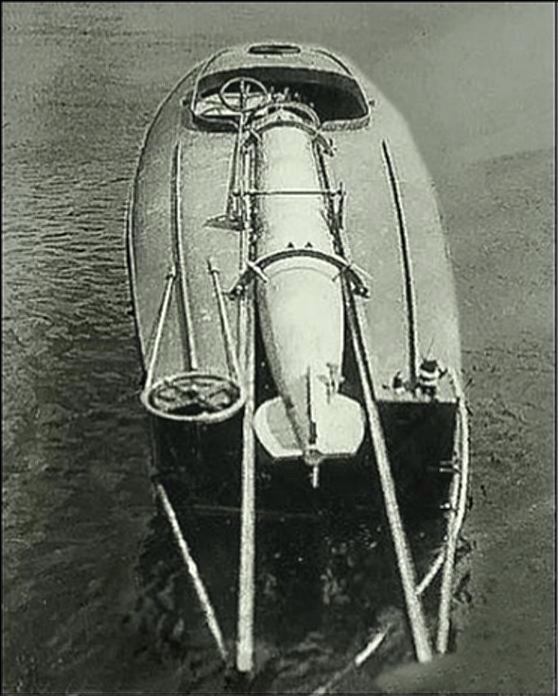
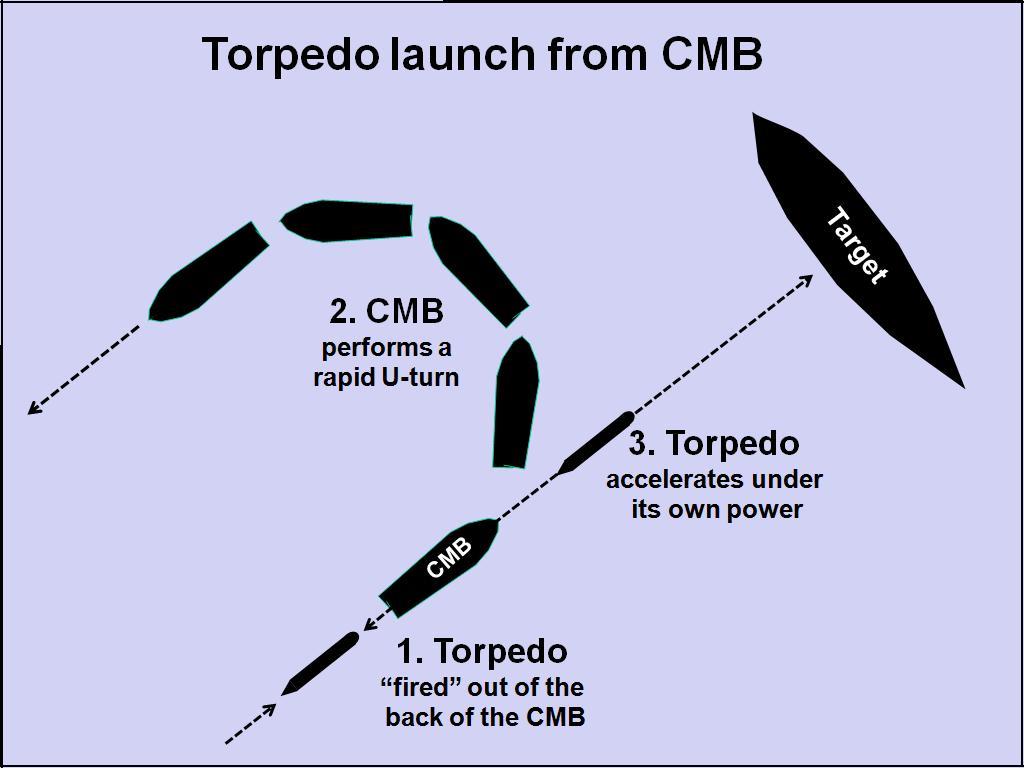
torpedo mounted in
the CMB the
launch maneuver
Royal Navy map from
the time showing the CMB storage & maintenance buildings, rail tracks,
pier, slipway and accommodation huts
select the map to
access an interactive version with links to 30 views from the ground taken
at the time
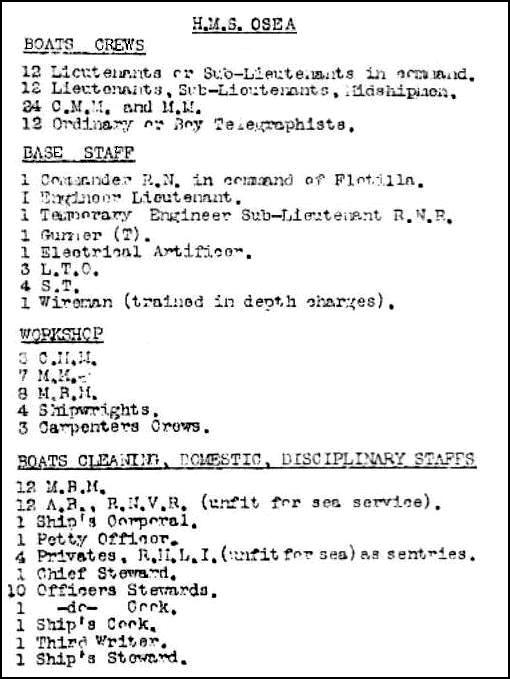
a list of personnel
stationed on the Island

North East
panoramic views of
the island taken from the water tower (water works on map above) showing most
of the buildings on the base

East South

CMB boat sheds and
launch tracks
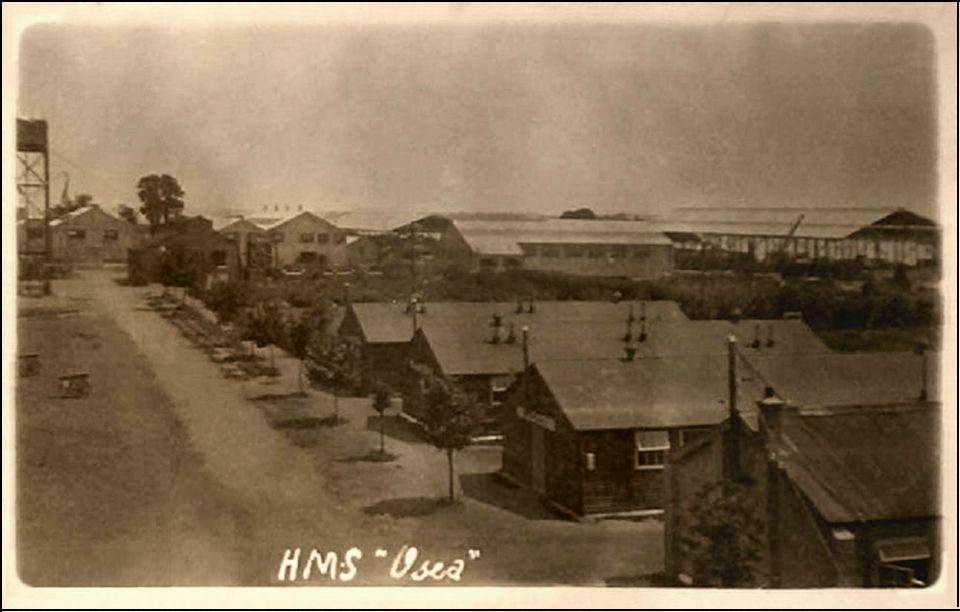
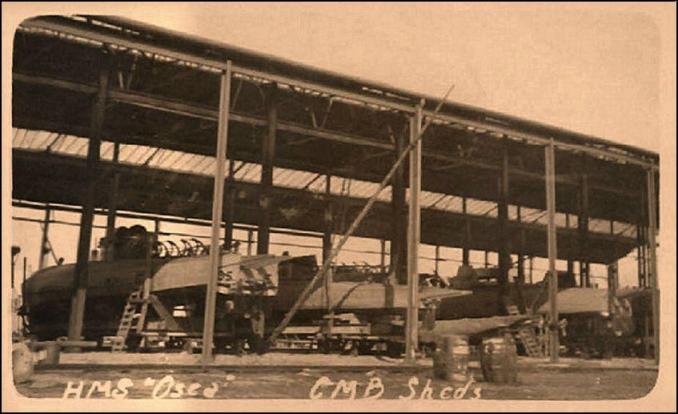
postcard views of
HMS Osea
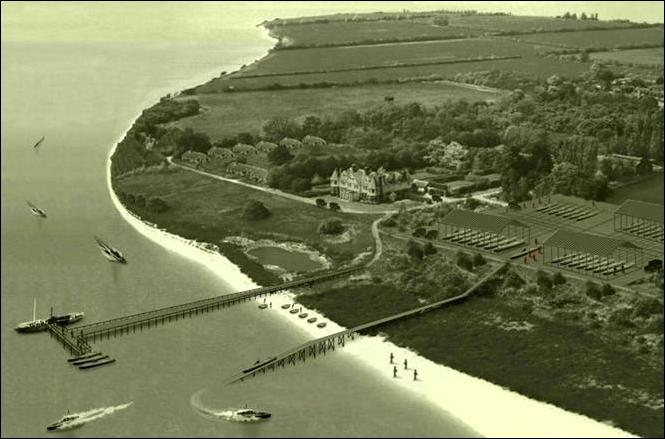
HMS Osea - a
photographic re-construction of the CMB sheds, tracks and slipway on the island
The
map and panoramic views indicate that over 40 huts were built on the island to
accommodate over 1000 navy personnel, which including a large number of
personnel from the newly formed Women's Royal Naval Service (WRNS). The
Imperial War Museum website has a collection of photographs of HMS Osea showing
the personnel at work (search Google images for: IMW HMS Osea).
About
30 large accommodation huts were built on Osea island and another eight on the
Goldhanger aerodrome site. After the war, it seems most of these, and another
eight on the Goldhanger aerodrome site, were purchased by May & Butcher
of Heybridge Basin and were sold on as private homes and holiday cottages. Many
were re-built along the Goldhanger Rd, Basin Rd and Wharf Rd in Heybridge.
The
huts were known as Armstrong huts
having acquired the name after a Major B H O Armstrong of the Directorate of
Fortifications and Works, that issued sets of drawings and orders for the
huts in August 1914. Although all of the same design and appearance, there were
several sizes: The basic size was 60 feet by 20 feet designed to accommodated
30 men, other sizes included 60 ft by 15 ft, 24 ft by 15 ft and 12 ft by 9 ft.
The huts were assembled on site by teams of carpenters, including many women,
using prefabricated parts and could easily be dismantled and moved. The history
of these buildings is given at…
About
a dozen buildings remained on the island and have been adapted and re-used…

Of
the many that were moved to the mainland and re-used as private homes, sixteen
can still be seen in Wharf Road, Basin Road and the Goldhanger Road in
Heybridge. Most have undergone much re-modelling over the years…

Many
other smaller huts were also sold on and re-used as farm buildings and garages,
etc. and remain in private hands the vicinity…
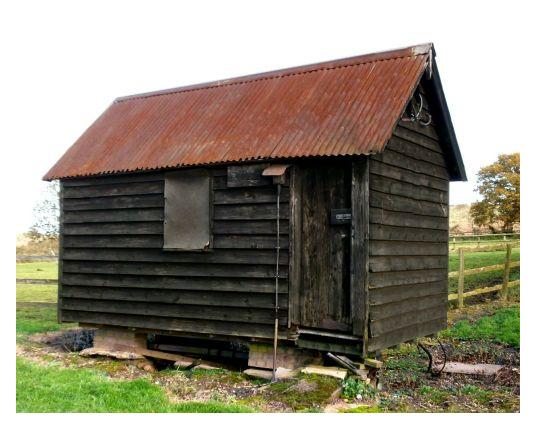
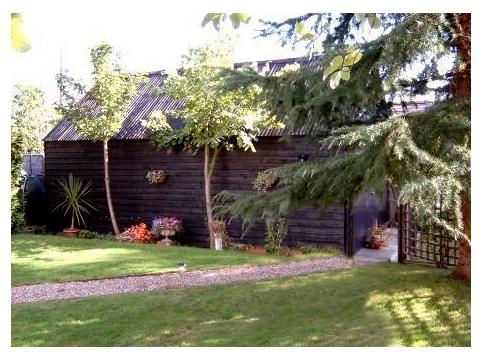
The
remnants of the slipway can still be seen on the island and other relics
remain. The large number of people and their operations on to the island are
said to have had an effect on the water table in the surrounding area and the
wells that people relied on for drinking water in Heybridge and Goldhanger had
to be re-dug to maintain local supplies.
HMS
Osea’s best known achievements
Perhaps
the most important and best know achievements of HMS Osea took place just after
the Great War when the UK’s attentions turned towards the Bolsheviks and the
Baltic Sea. In late 1918 Commodore Augustus Agar was asked to “volunteer” for a
mission in the Baltic Sea and CMBs were to be used to ferry British agents back
and forth from Bolshevik Russia
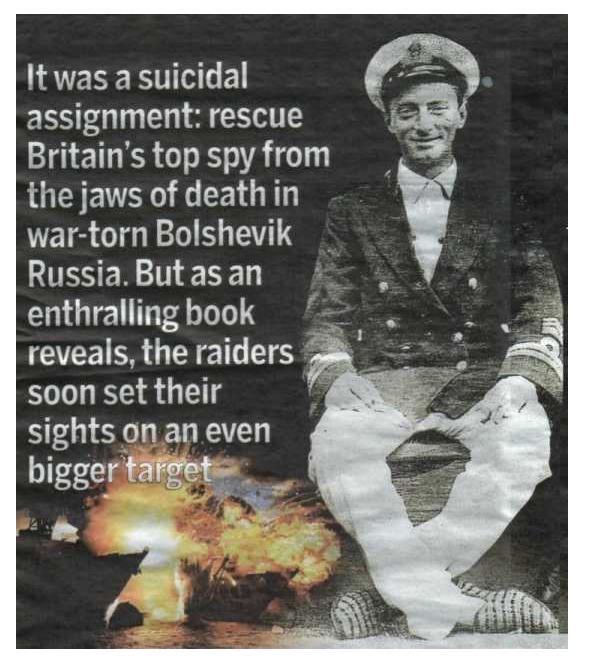 Commodore
Augustus Willington Shelton Agar, VC, DSO, RN (1890-1968) was a recipient of
the Victoria Cross while based at Osea
Island. In late 1918 he was asked to “volunteer”
for a mission in the Baltic Sea and CMBs were to be used to ferry British
agents back and forth from Bolshevik Russia. Agar and his crews dressed in civilian
clothes, they had a uniform on board in case they were in danger of capture.
Without the uniform, they could be shot as spies. The Bolsheviks had seized
much of the Russian fleet at Kronstadt, Agar considered these vessels a menace
to British operations so took it upon himself to attack them. They attacked a
Russian cruiser, the 6,645 ton Oleg and sunk it, after which Lieutenant Agar
retired to the safety of the open bay under heavy fire. For this he was awarded
the Victoria Cross and was promoted to Lieutenant Commander on 30 June 1919.
Commodore
Augustus Willington Shelton Agar, VC, DSO, RN (1890-1968) was a recipient of
the Victoria Cross while based at Osea
Island. In late 1918 he was asked to “volunteer”
for a mission in the Baltic Sea and CMBs were to be used to ferry British
agents back and forth from Bolshevik Russia. Agar and his crews dressed in civilian
clothes, they had a uniform on board in case they were in danger of capture.
Without the uniform, they could be shot as spies. The Bolsheviks had seized
much of the Russian fleet at Kronstadt, Agar considered these vessels a menace
to British operations so took it upon himself to attack them. They attacked a
Russian cruiser, the 6,645 ton Oleg and sunk it, after which Lieutenant Agar
retired to the safety of the open bay under heavy fire. For this he was awarded
the Victoria Cross and was promoted to Lieutenant Commander on 30 June 1919.
On
18 August 1919, Agar took his remaining boat against the Russians, acting as
guide-ship to a flotilla of six others, leading them through the minefields and
past the forts. Agar's boat was ordered to stay outside the harbour, and the
attack was lead by Commander Claude Dobson, but they entered Kronstadt harbour,
this time sinking two battleships, the 23,360 ton dreadnought Petropavlovsk and
the 17,400 ton pre-dreadnought Andrei Pervozvanny, and a submarine depot ship,
the 6,734 ton Pamiat Azova. In 1961 Captain Agar published his mémoires in
"Footprints in the Sea".
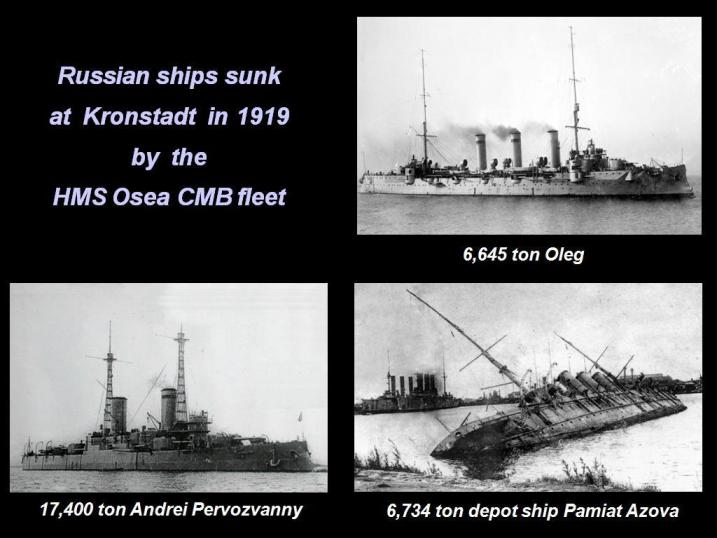
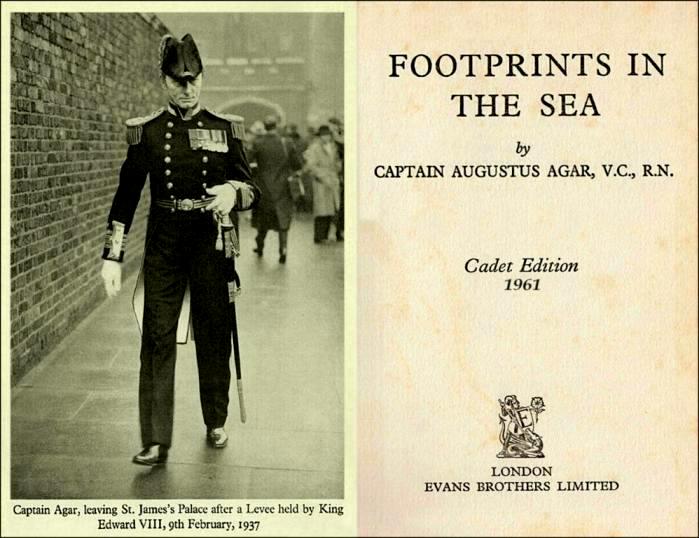
From The Admiralty
Register of 1919…
The
King is pleased to approve of the award of the Victoria Cross
to the under mentioned Officers:
Commander
Claude Congreve Dobson, D.S.O., R.N.
conspicuous
gallantry, skill and devotion to duty in the
attack
on Kronstadt Harbour in CMB-31. 18th Aug 1919
Lieutenant
Gordon Charles Steele, R.N.
conspicuous
gallantry, skill and devotion to duty in the
attack
on Kronstadt Harbour in CMB-88. 18th Aug 1919
Lieutenant
Augustine Wellington Shelton Agar, DSO,
RN
conspicuous
gallantry, coolness and skill under
extremely
difficult conditions in action. 22nd Aug 1919
Commodore Agar’s
CMB at Duxford
Four
IWM WW1 films of HMS Osea
have been identified and can be accessed via the… Goldhanger related videos
page.
There
are also many photographs of HMS
Osea held in the IWM at… https://www.iwm.org.uk/collections/search=WRNS osea
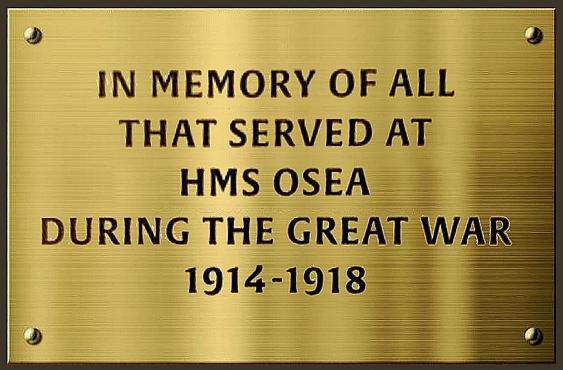
a plaque on Osea
Island
top Commemoration of the 100th anniversary of WW-1 Memories
of World War Two home
